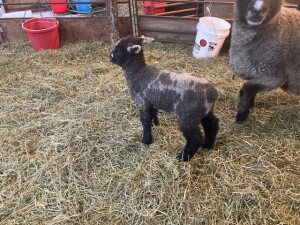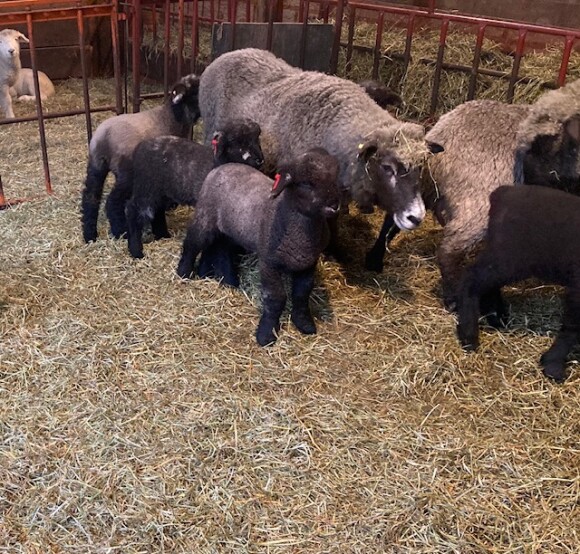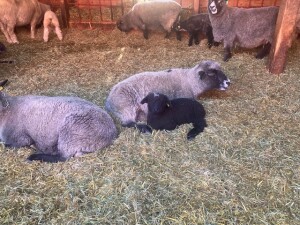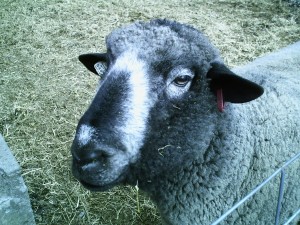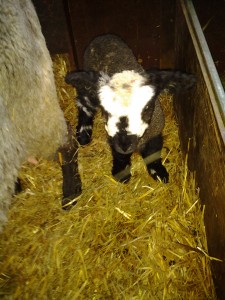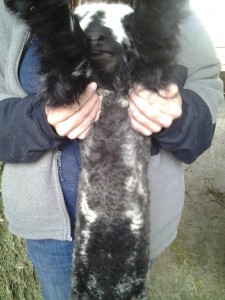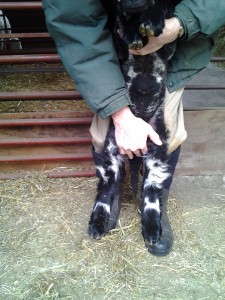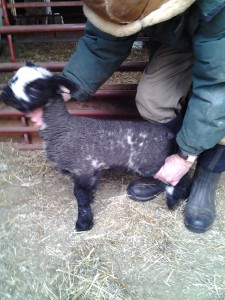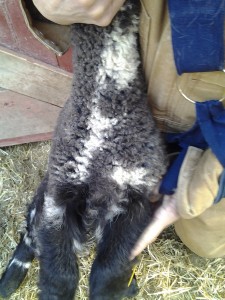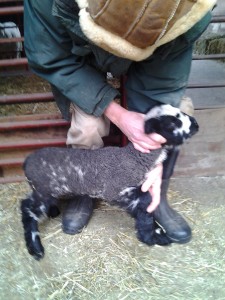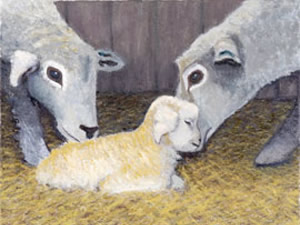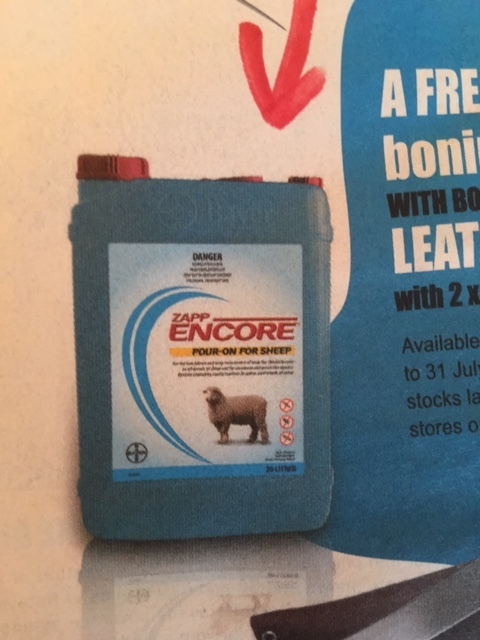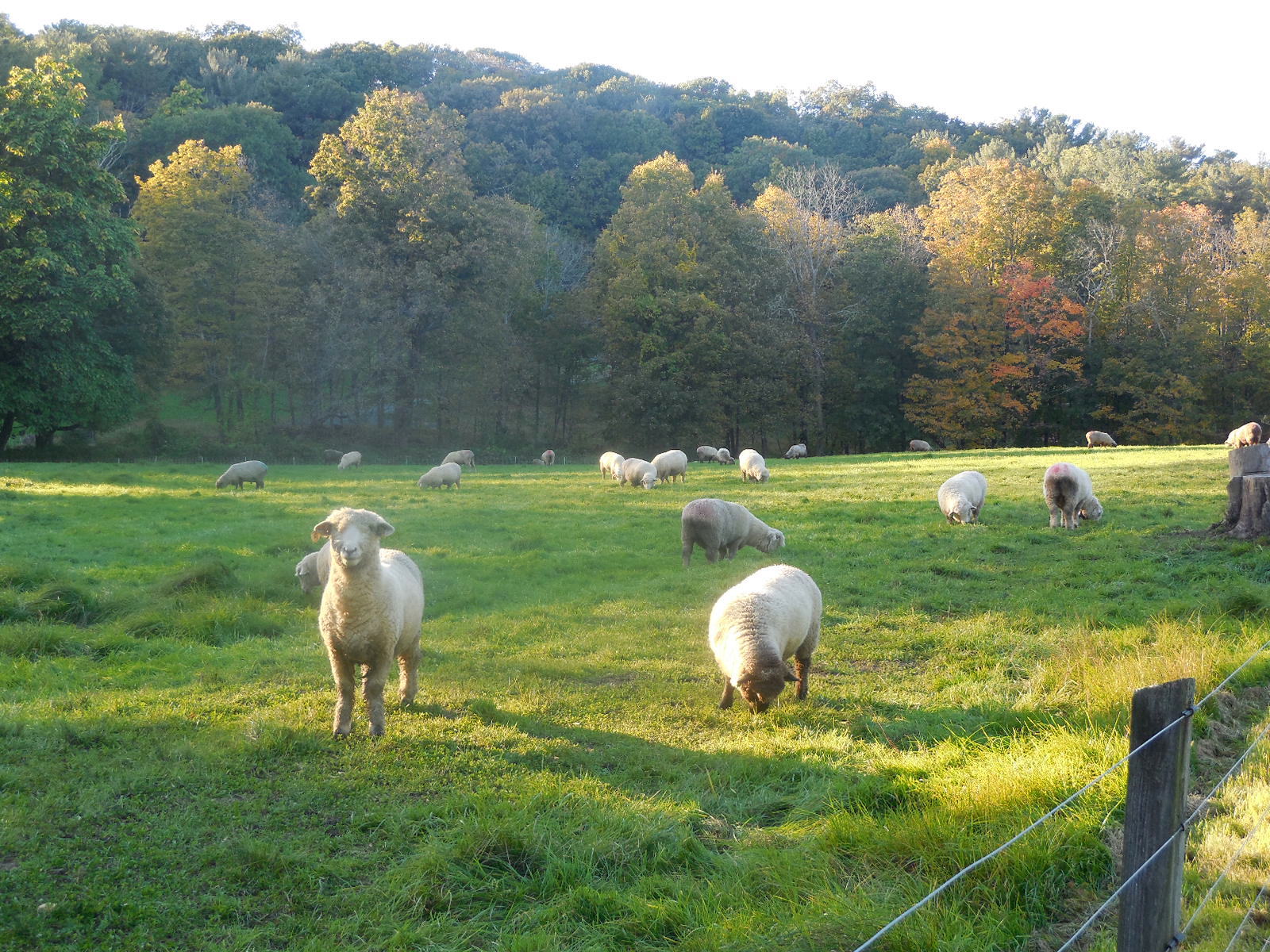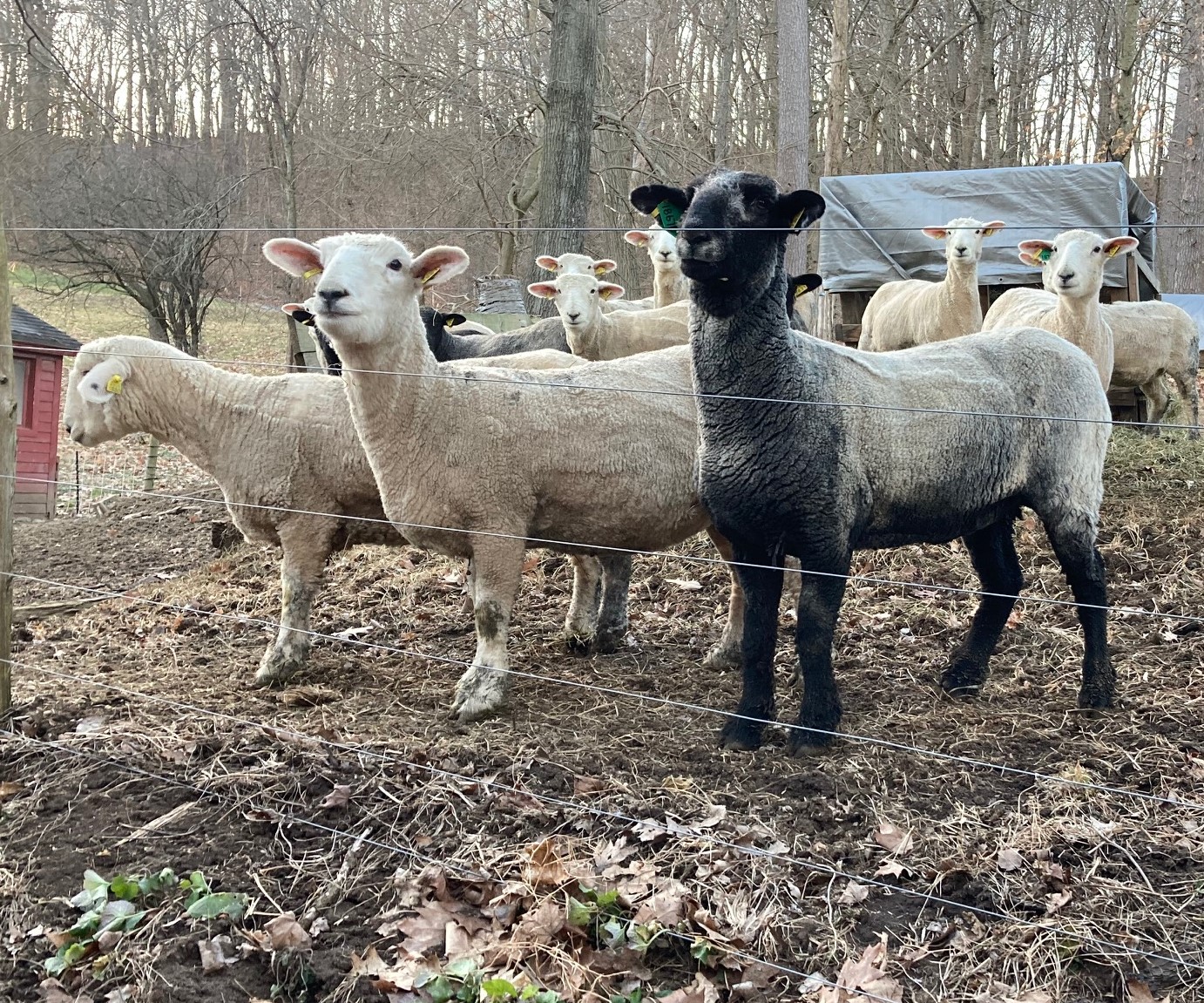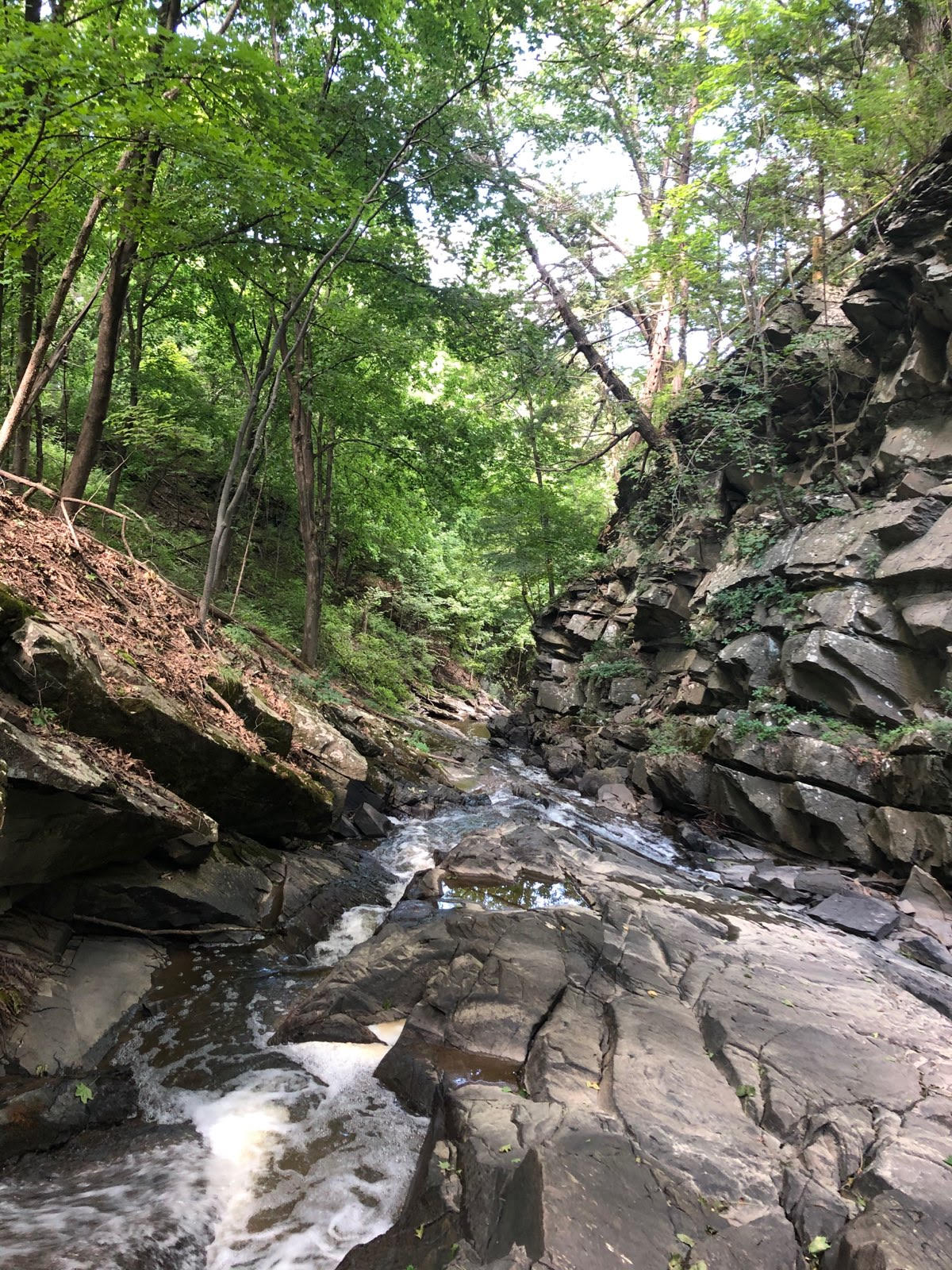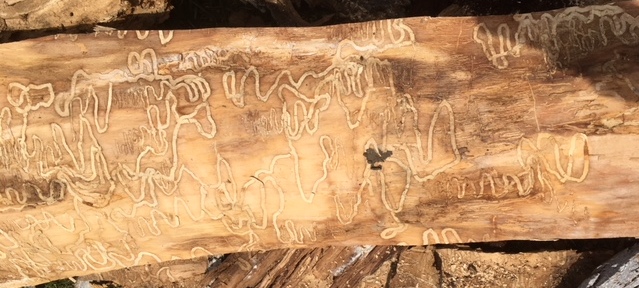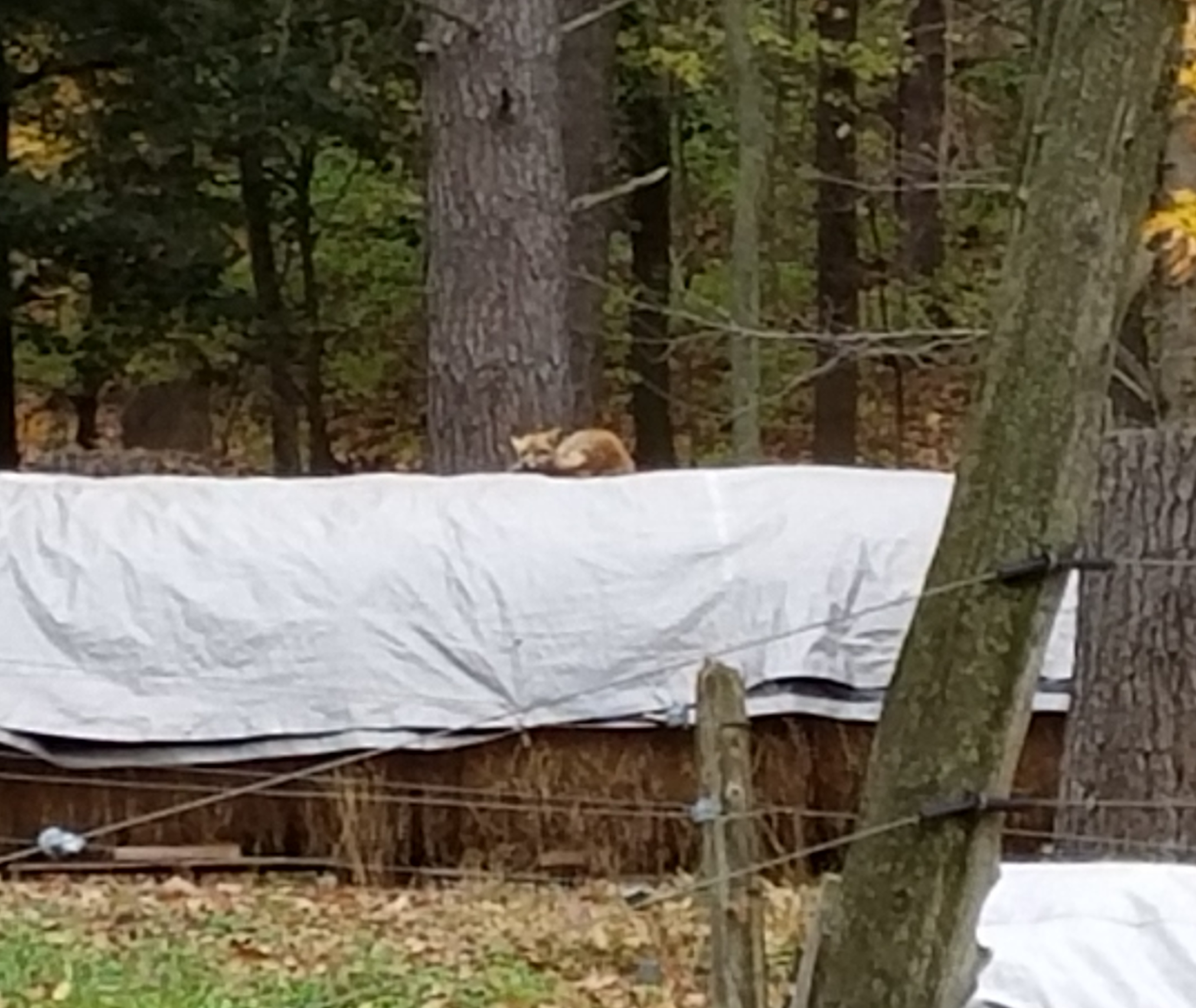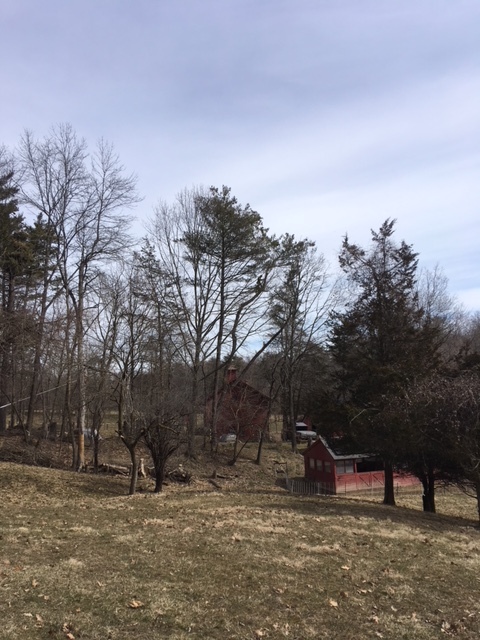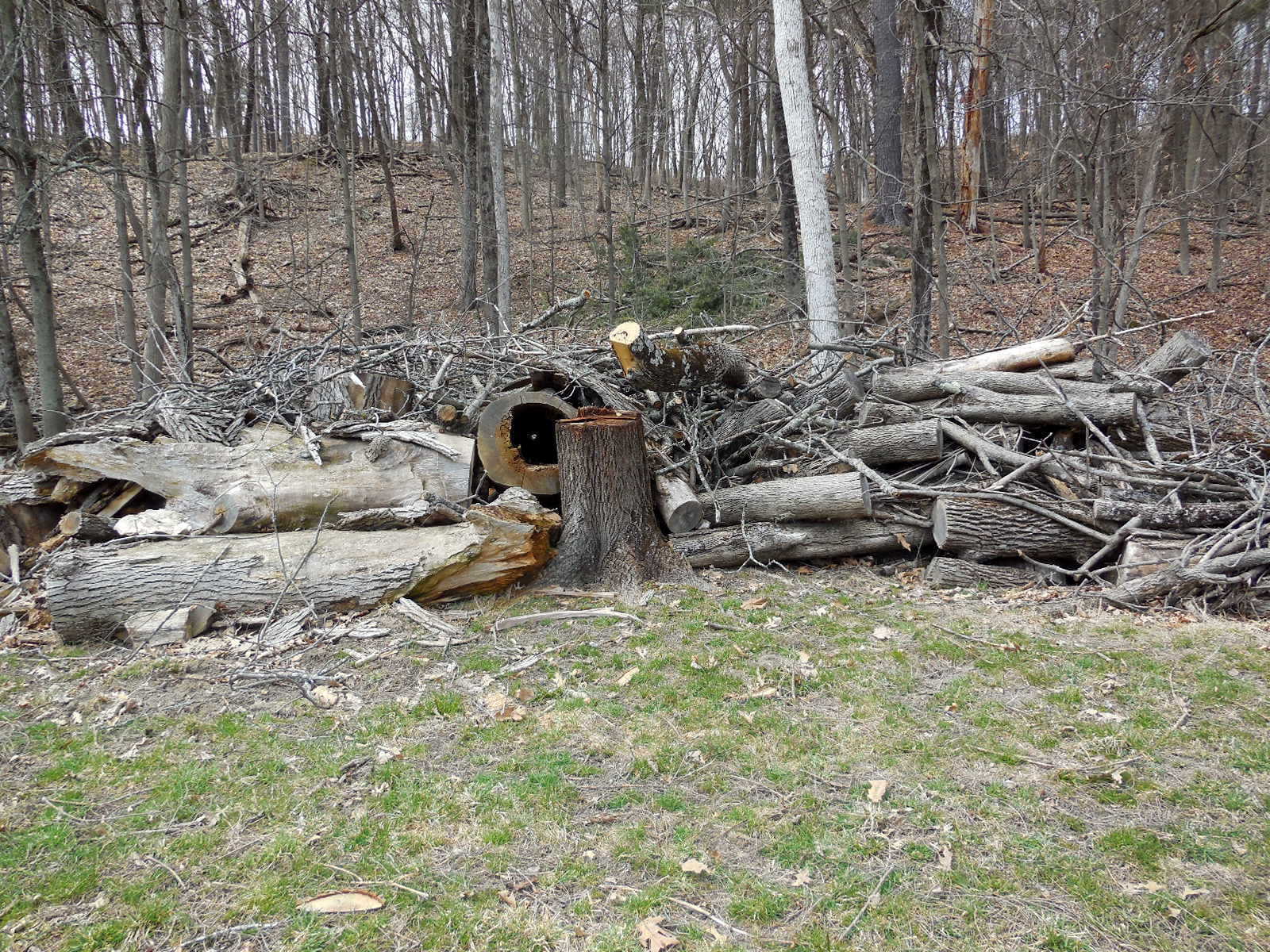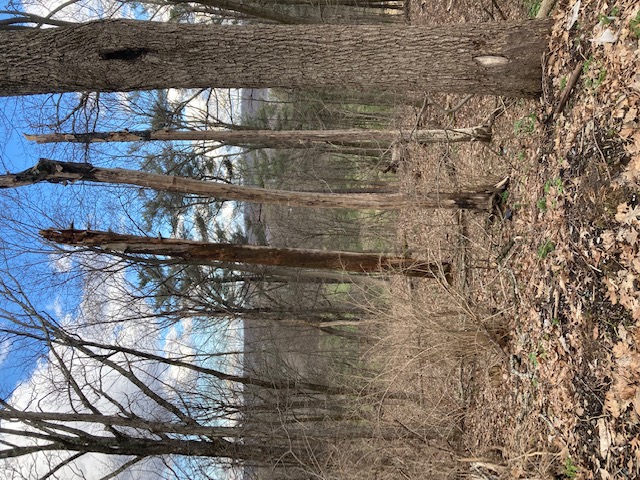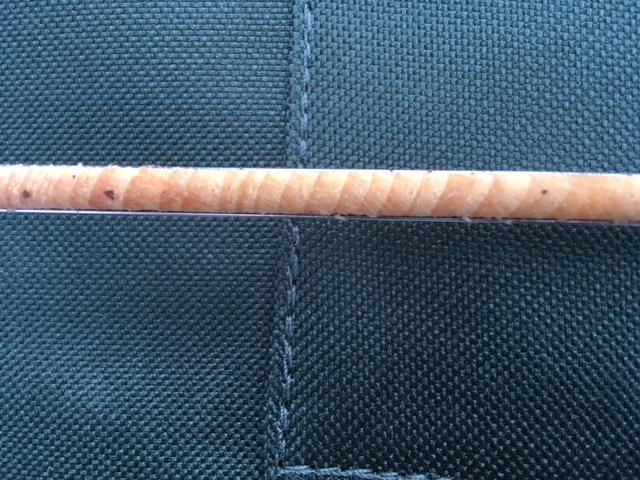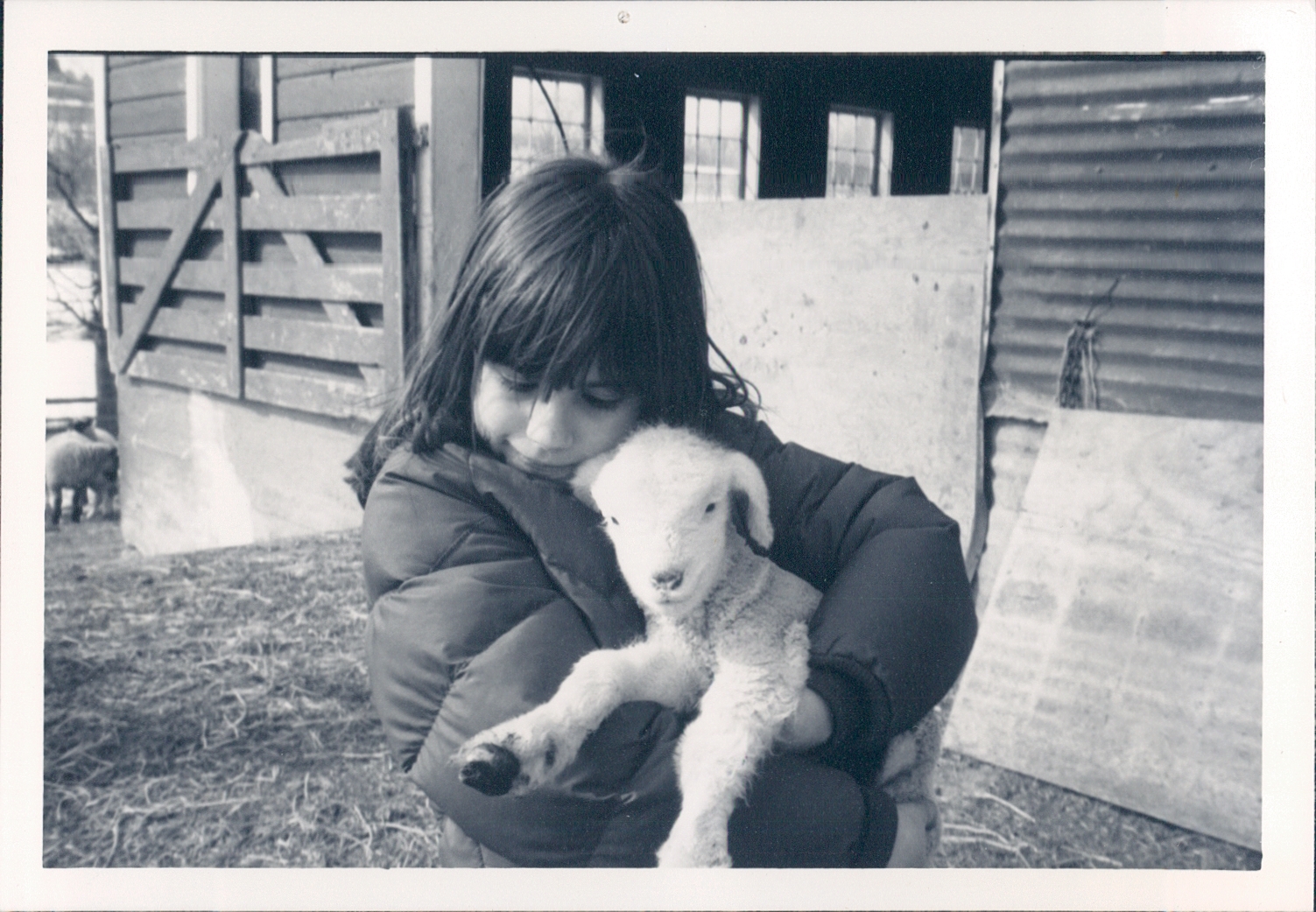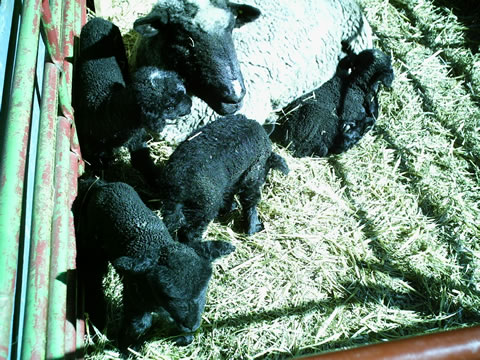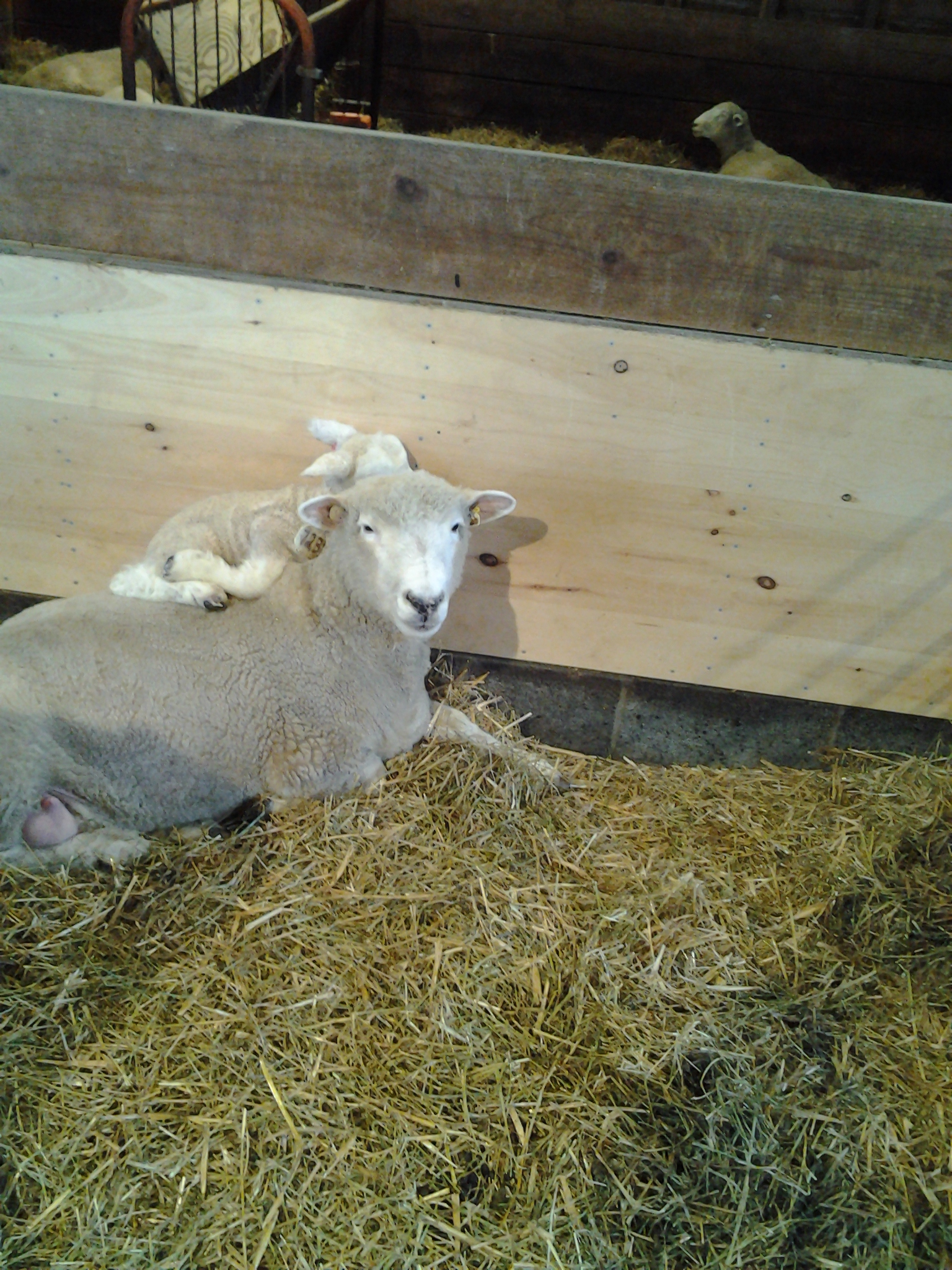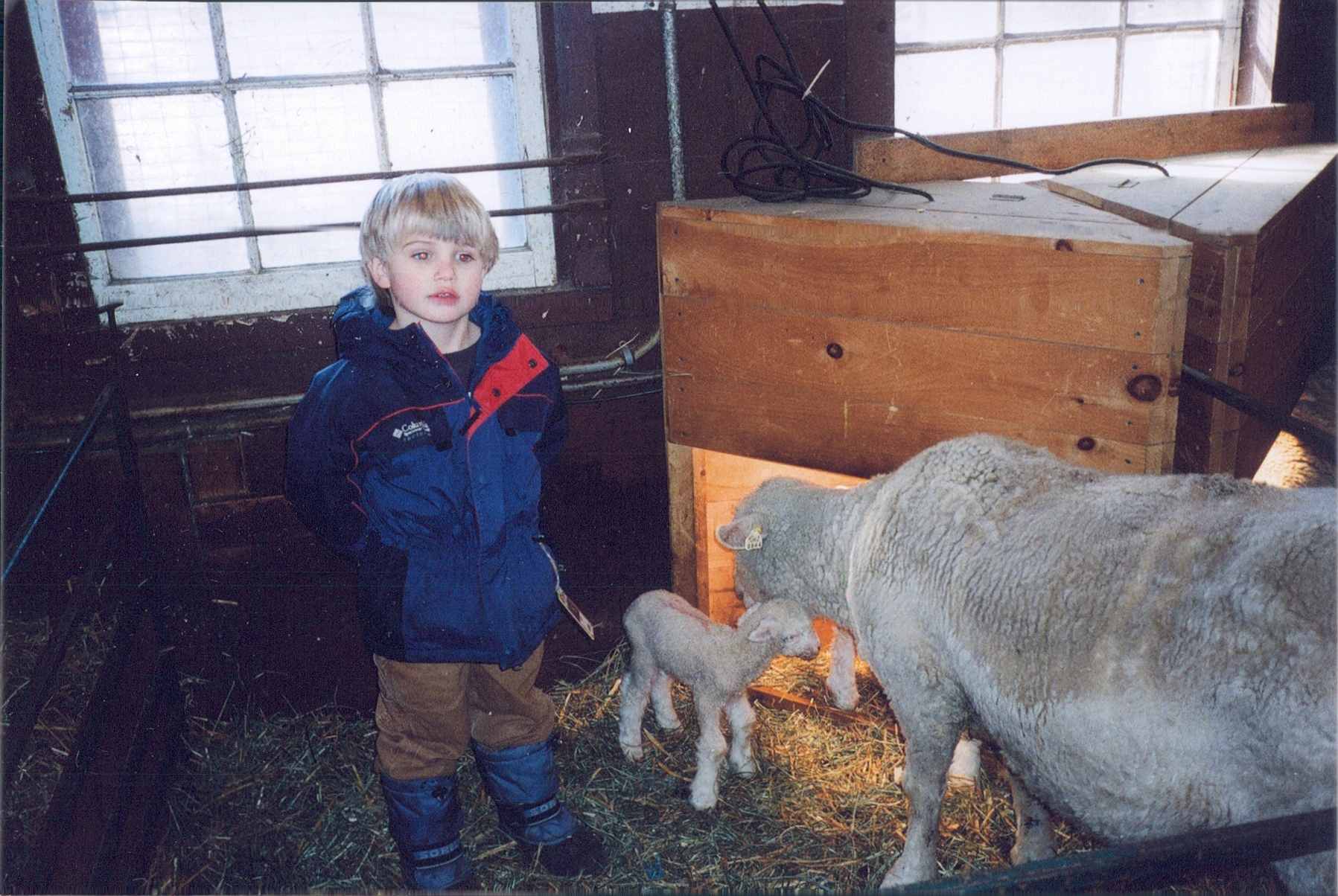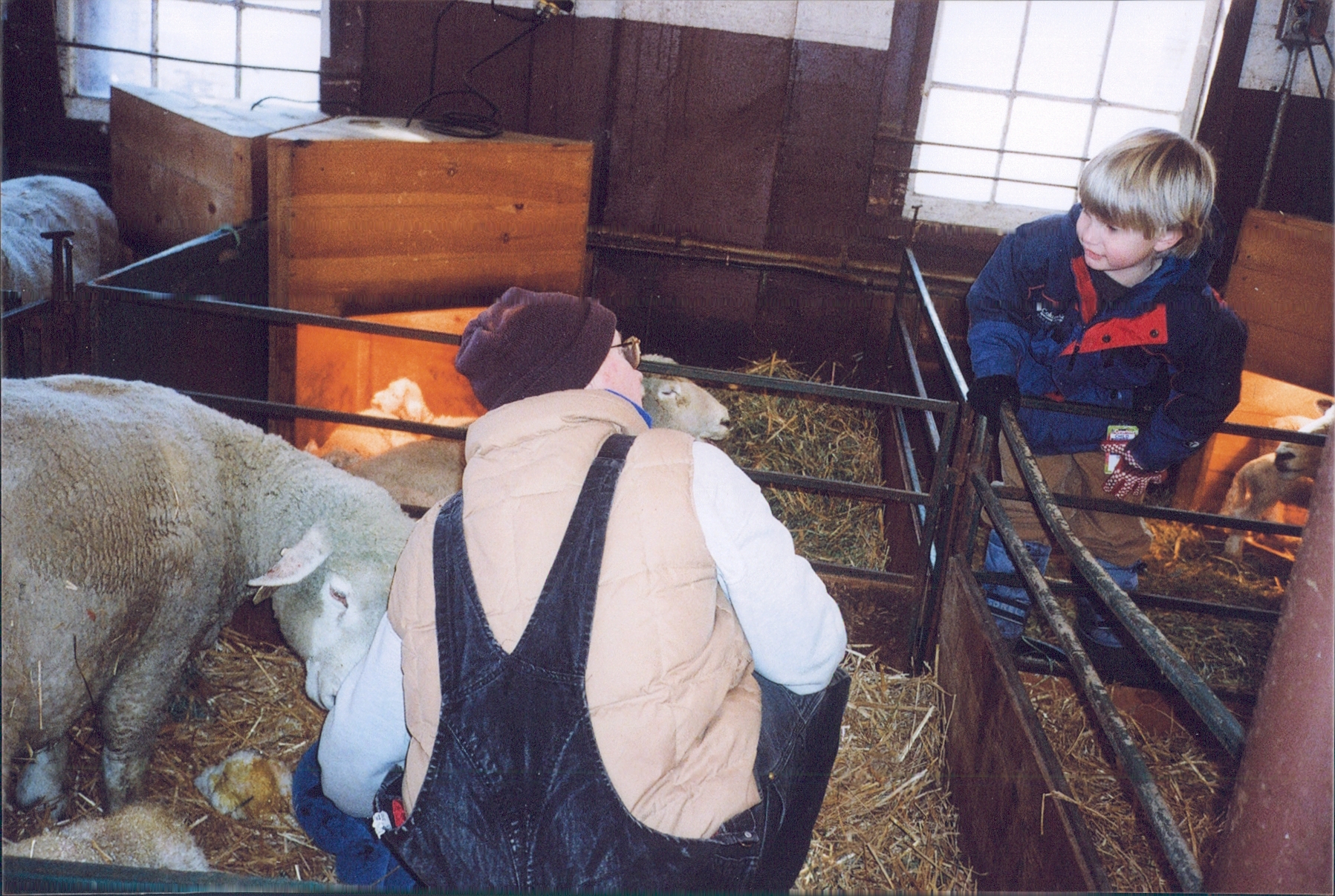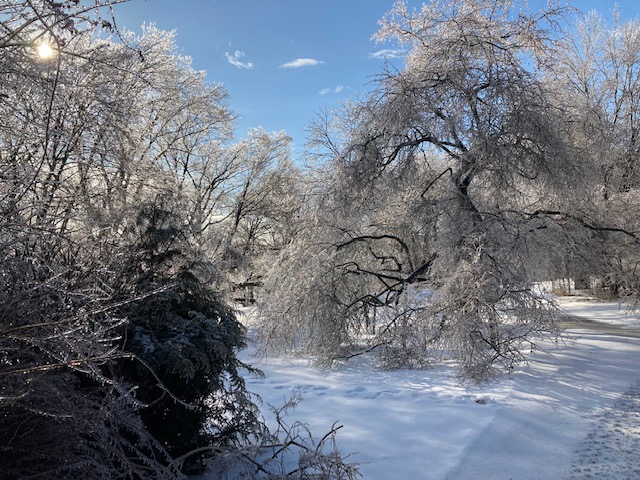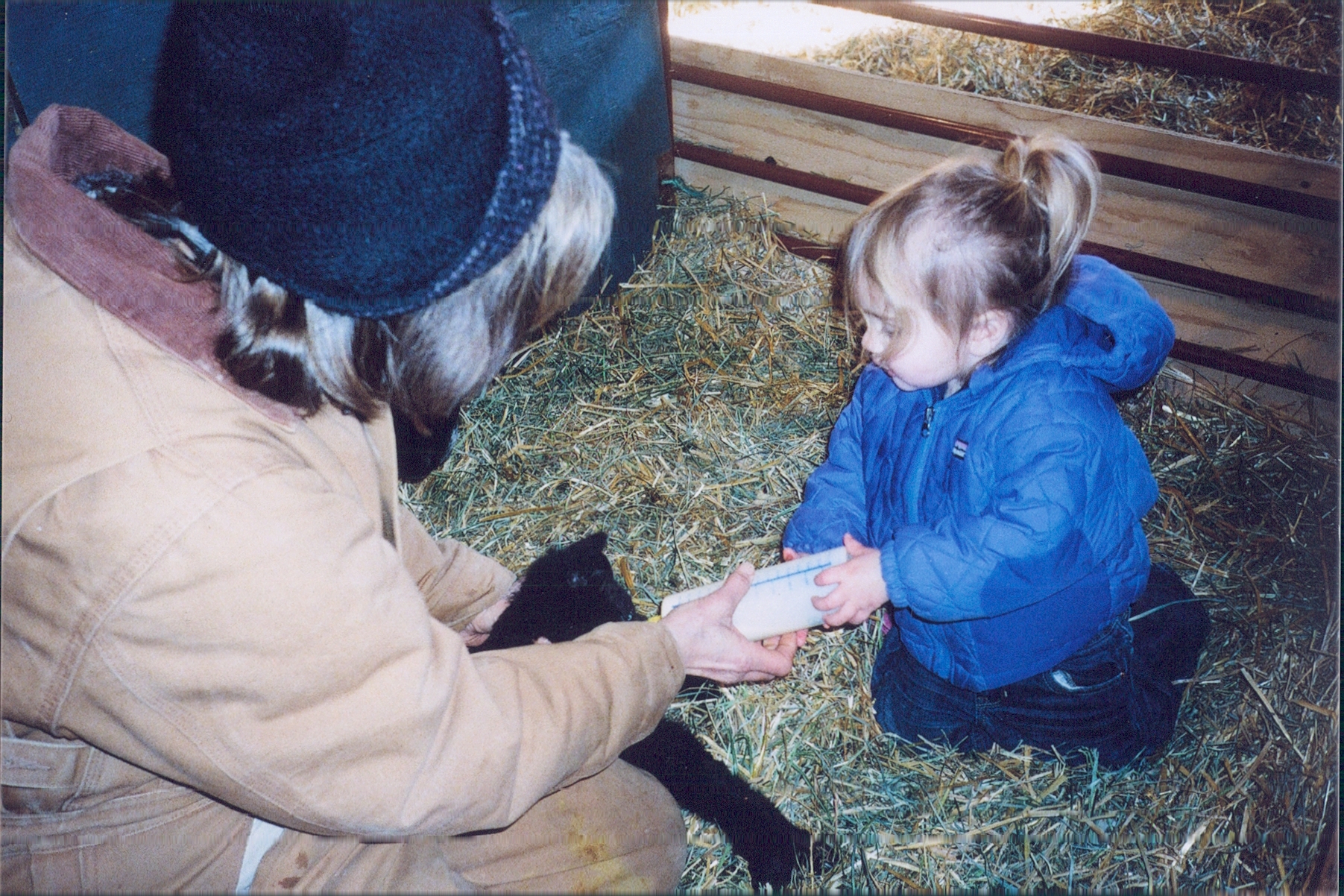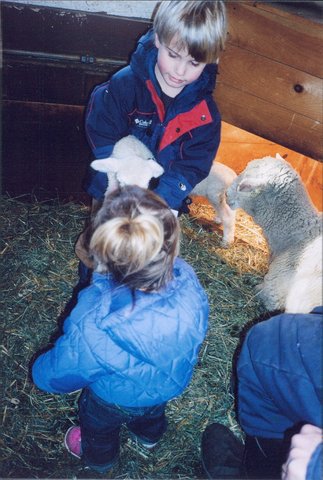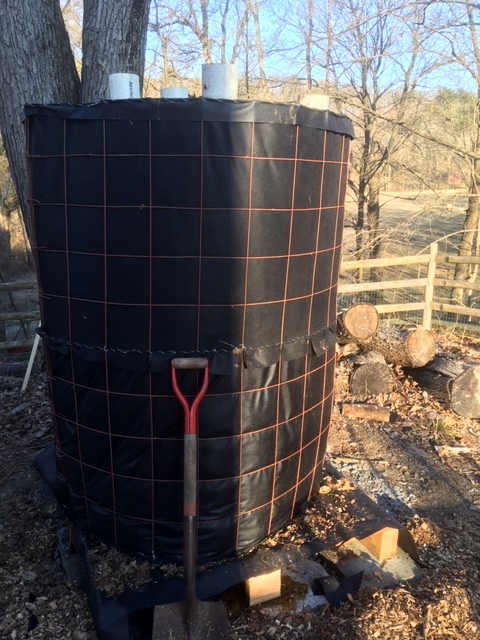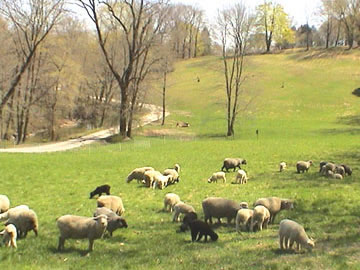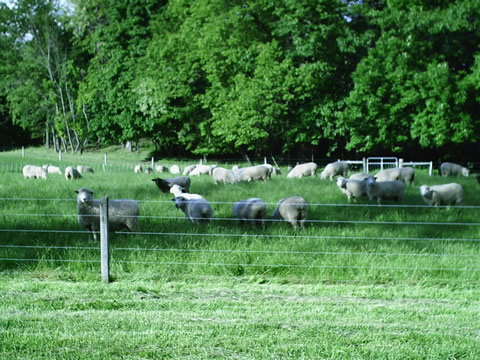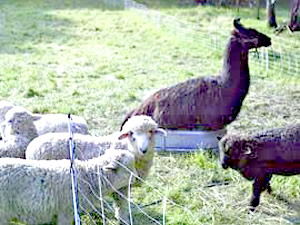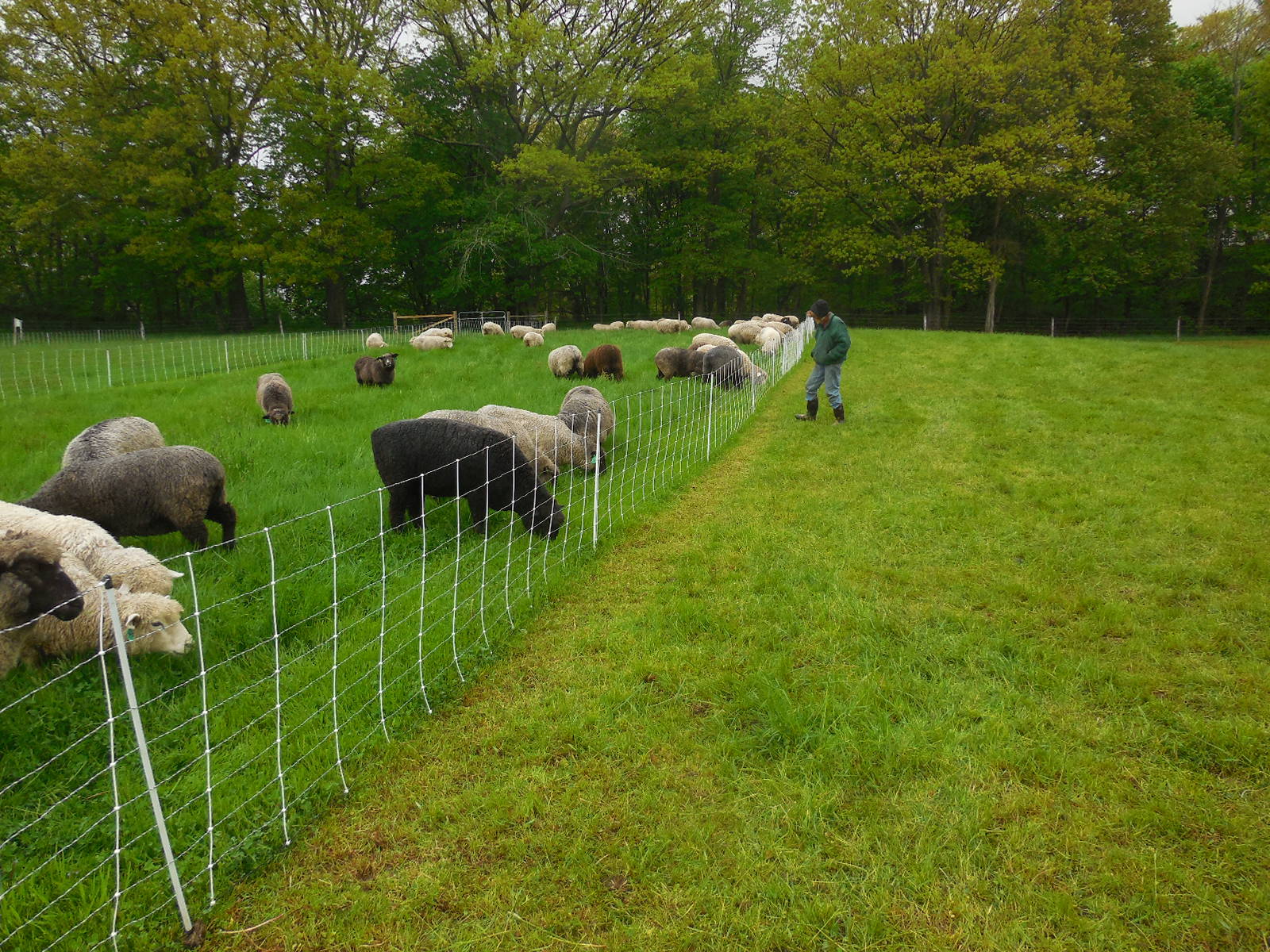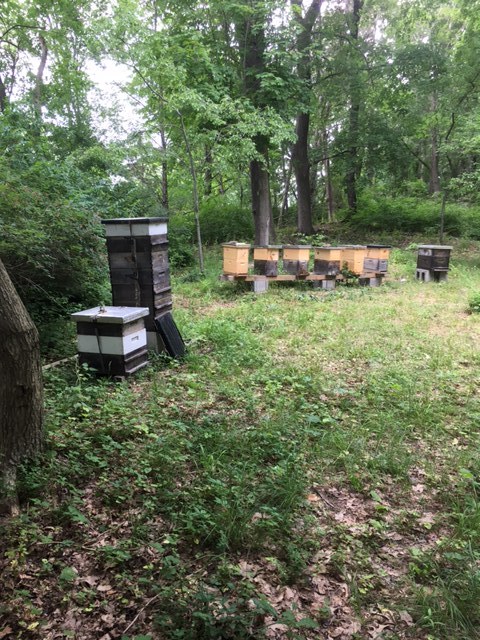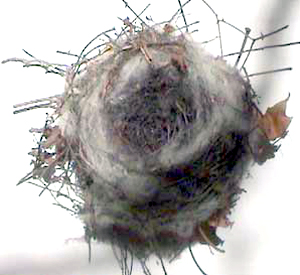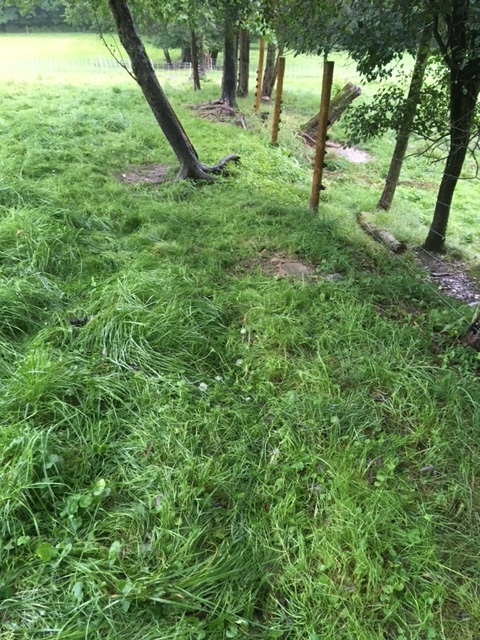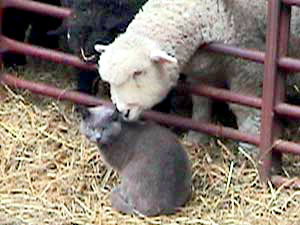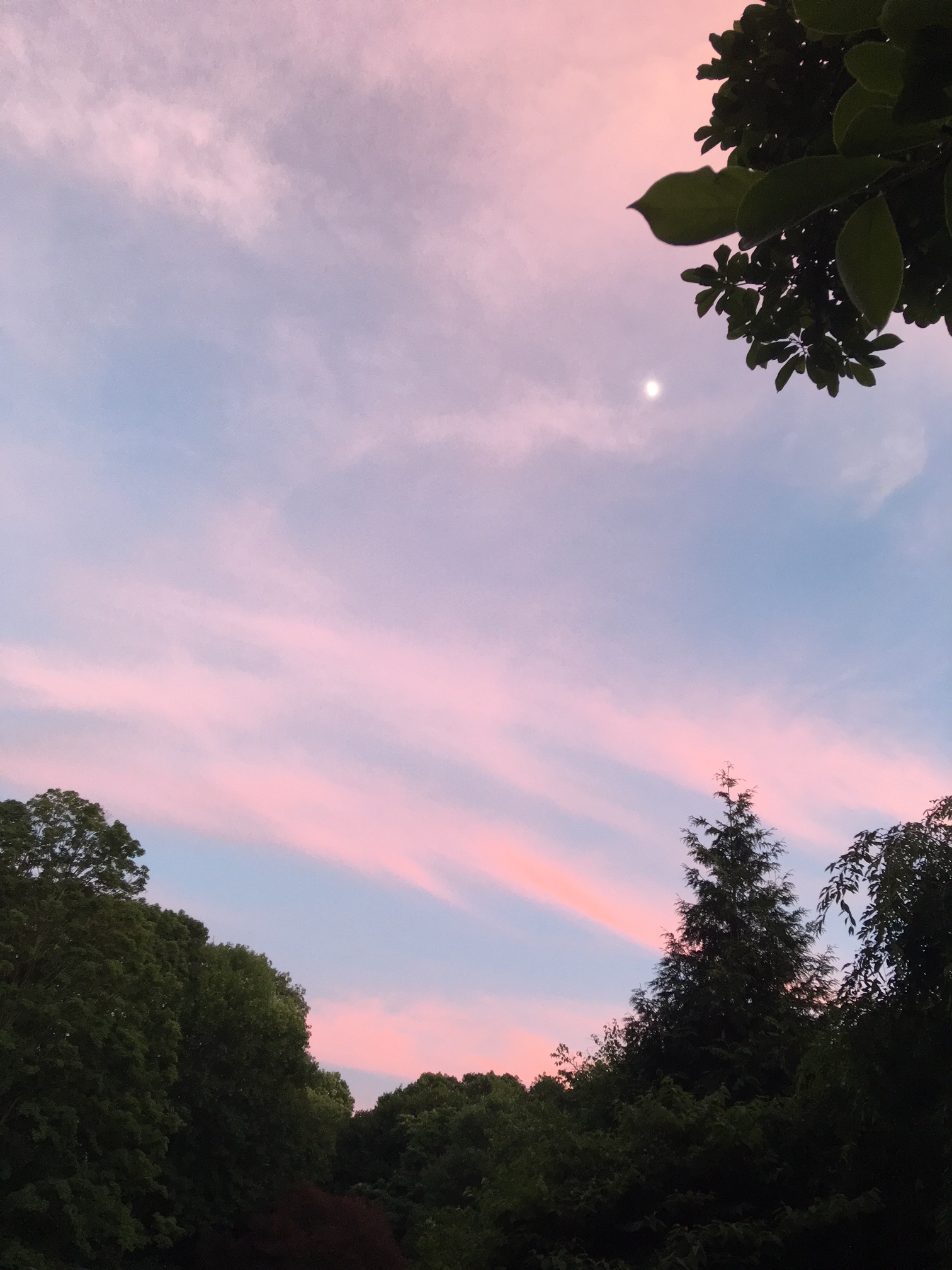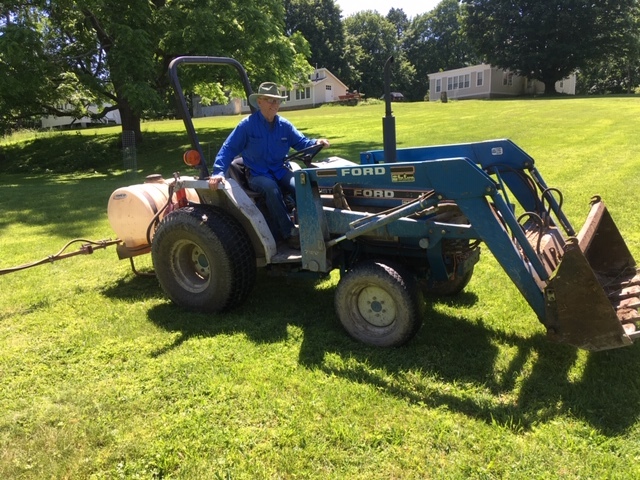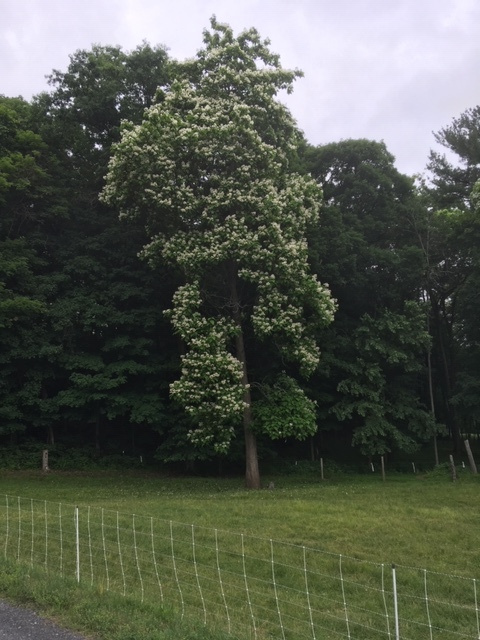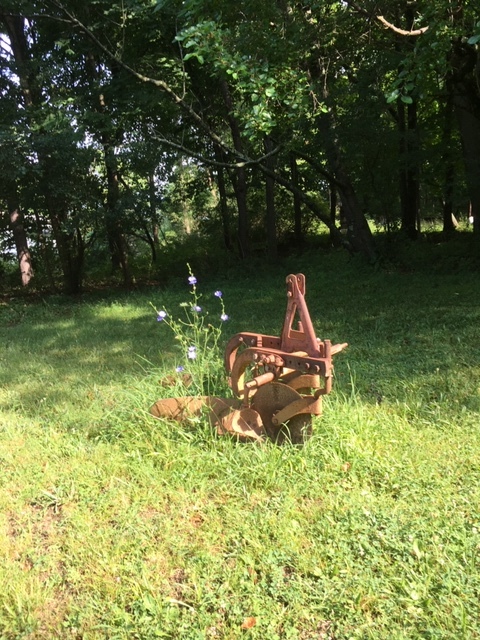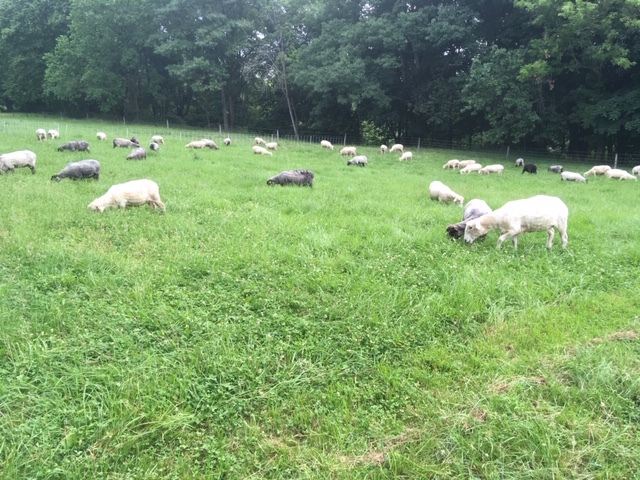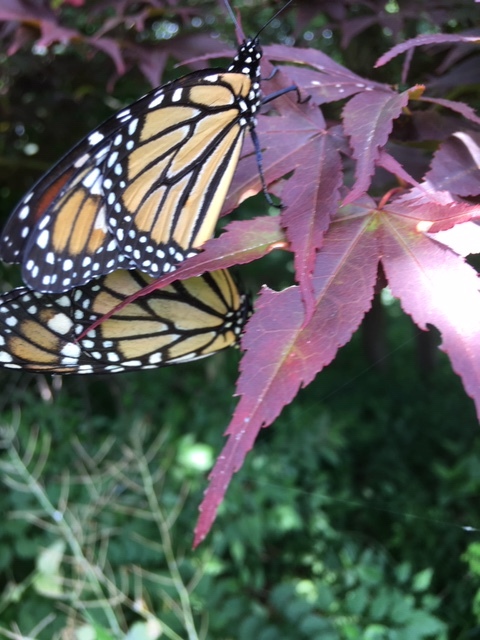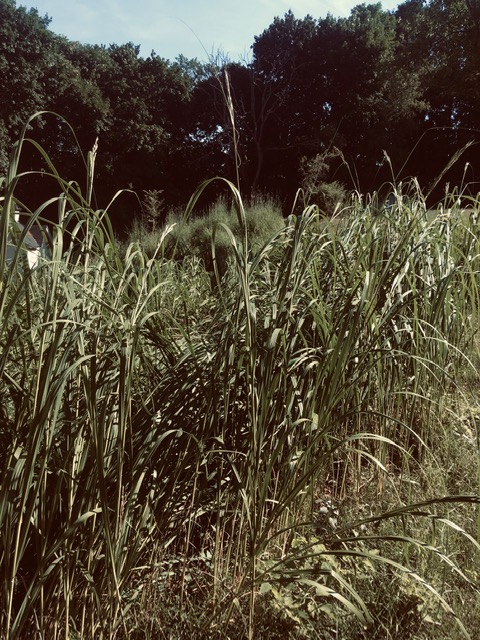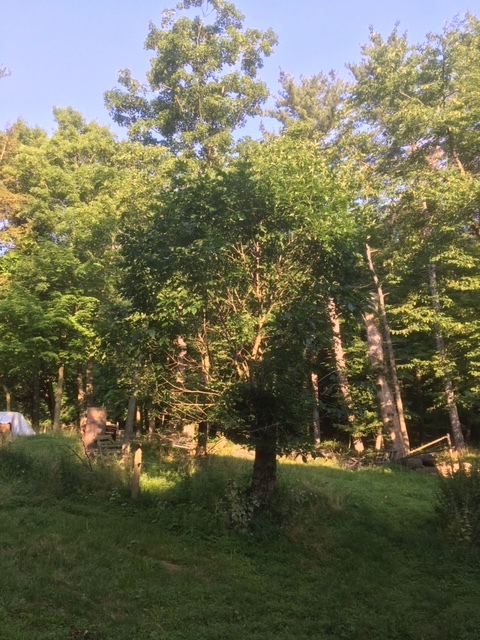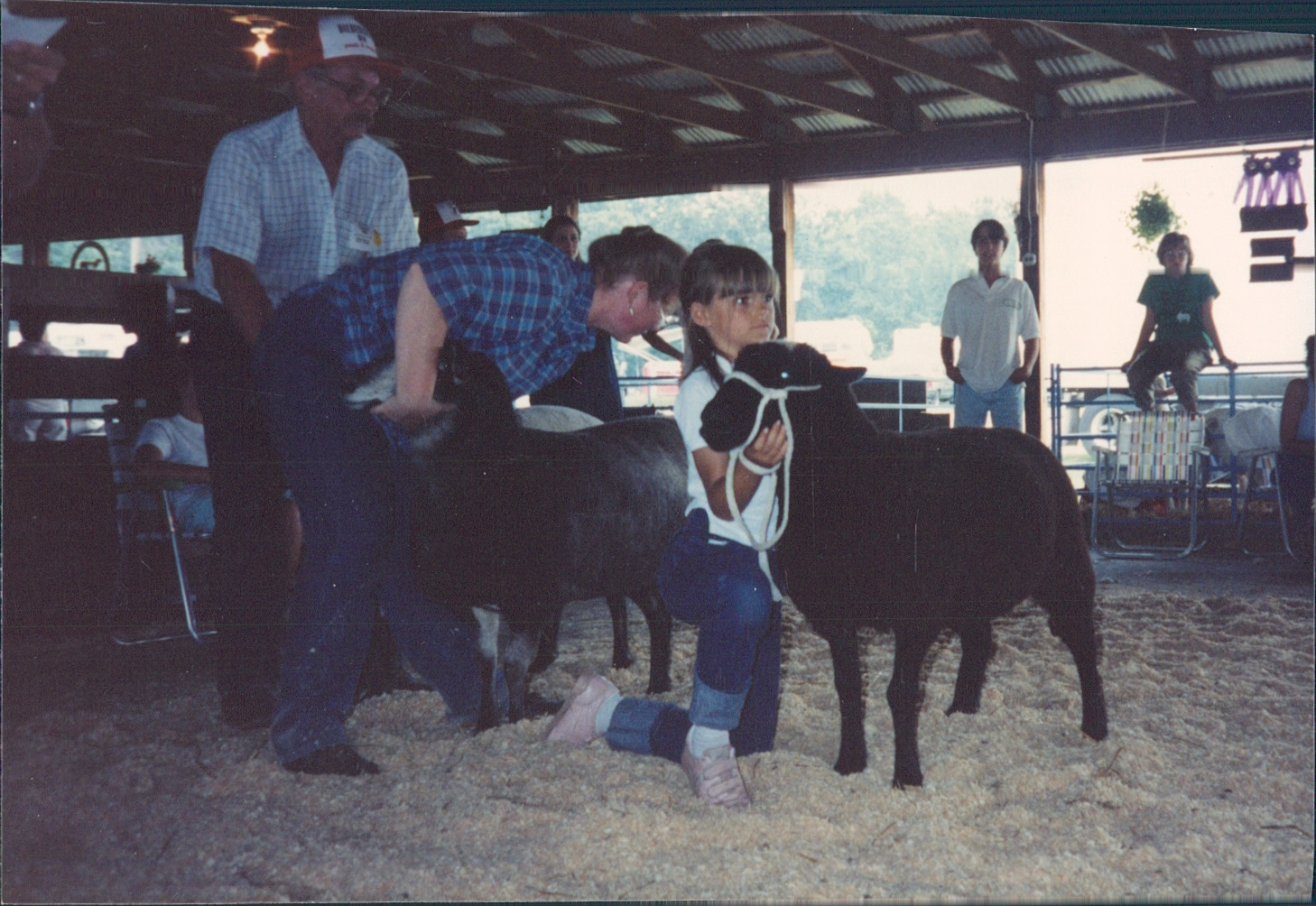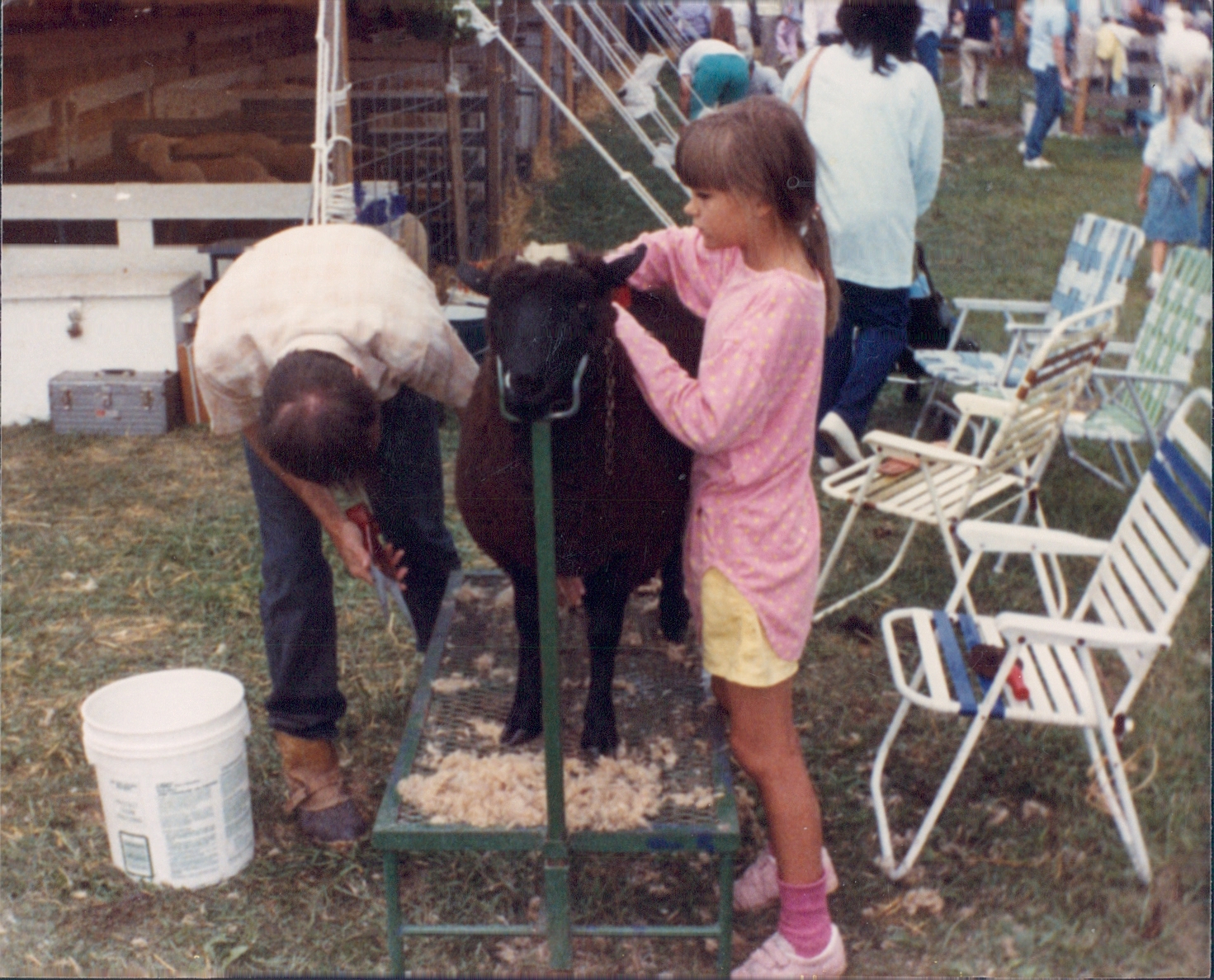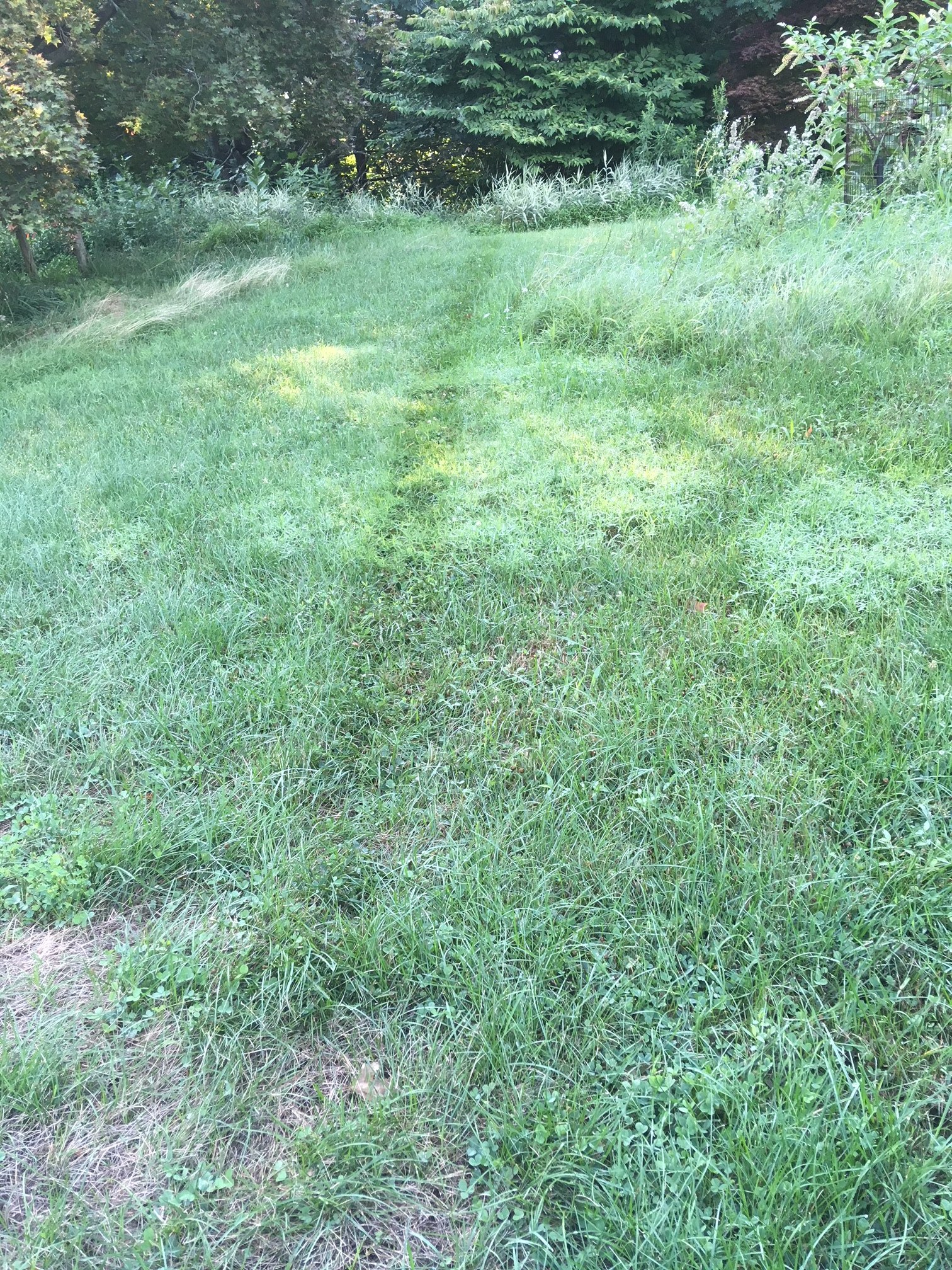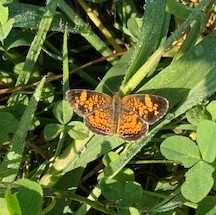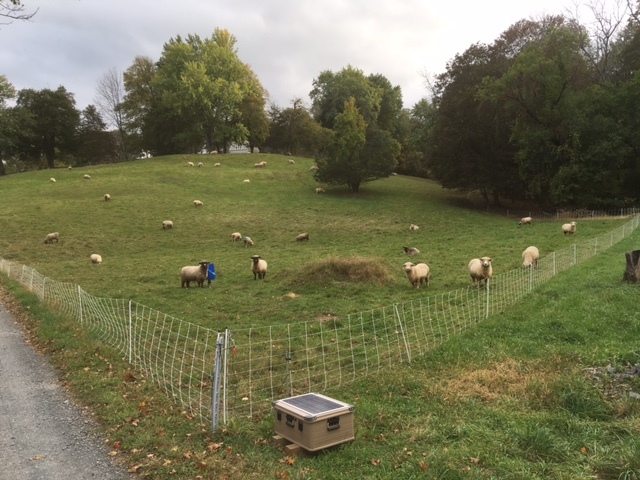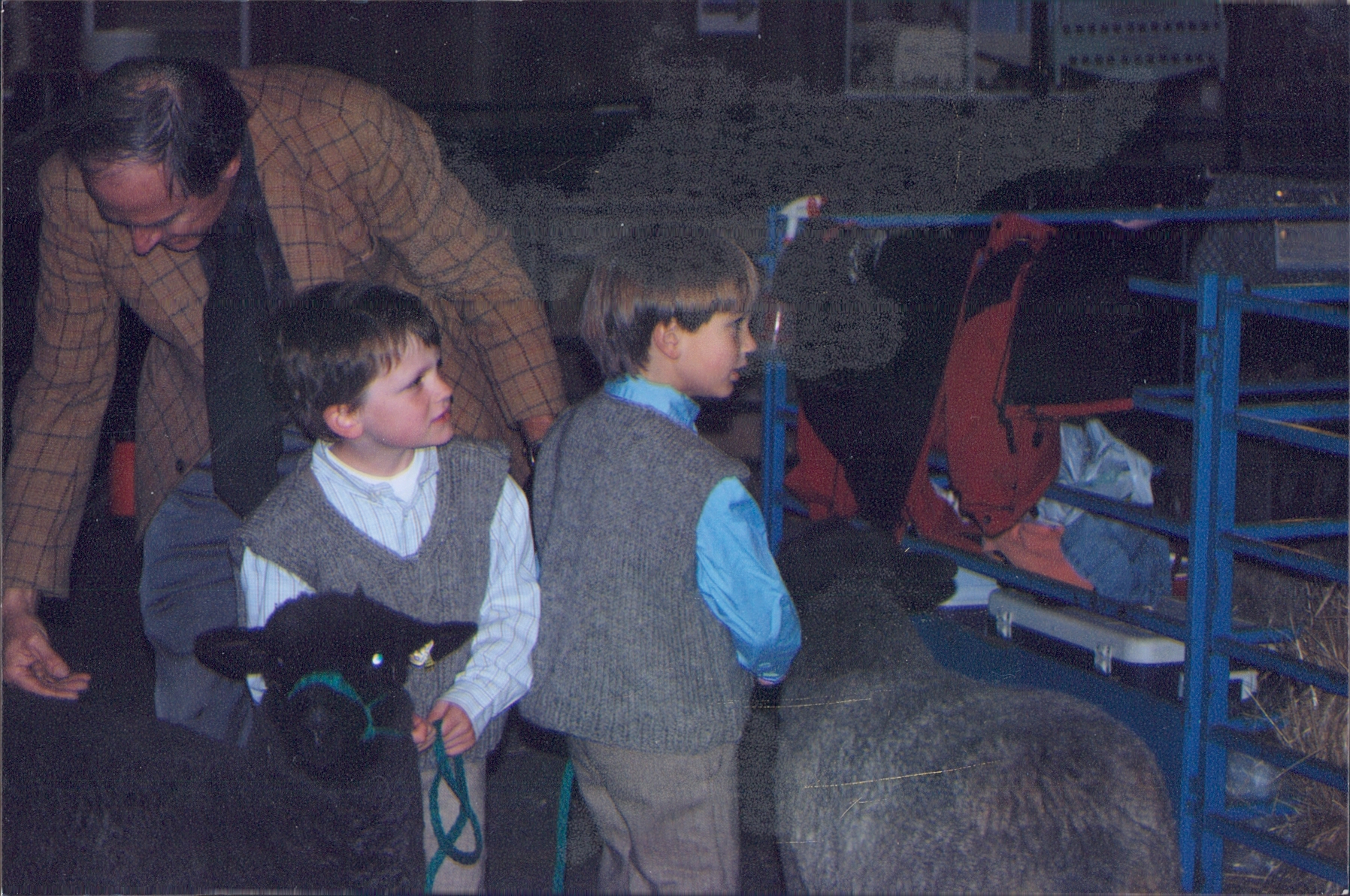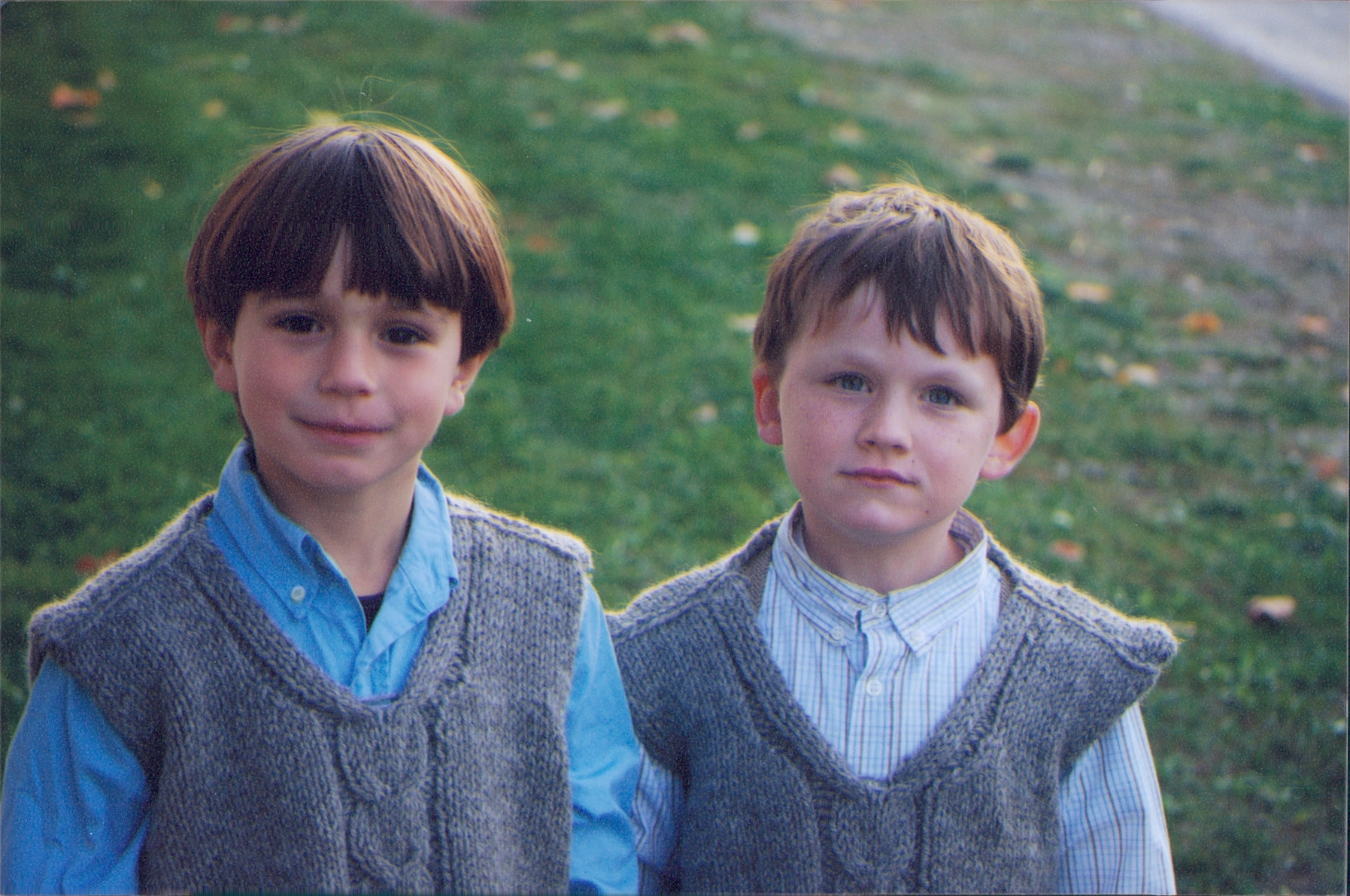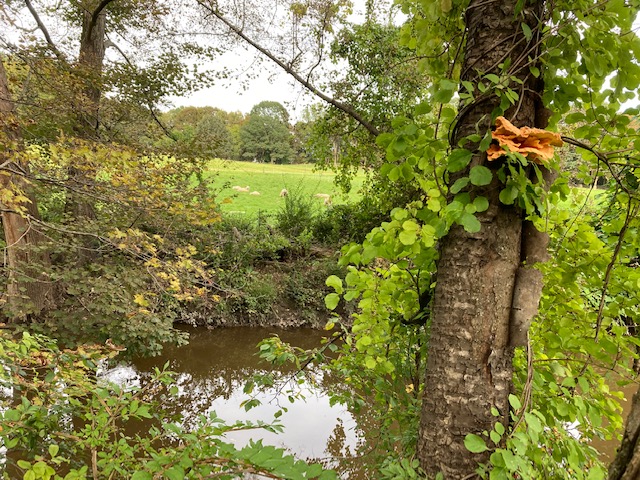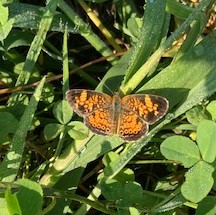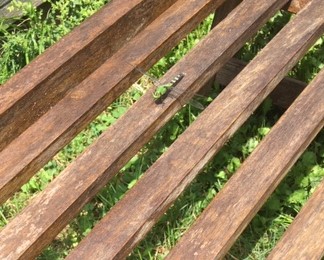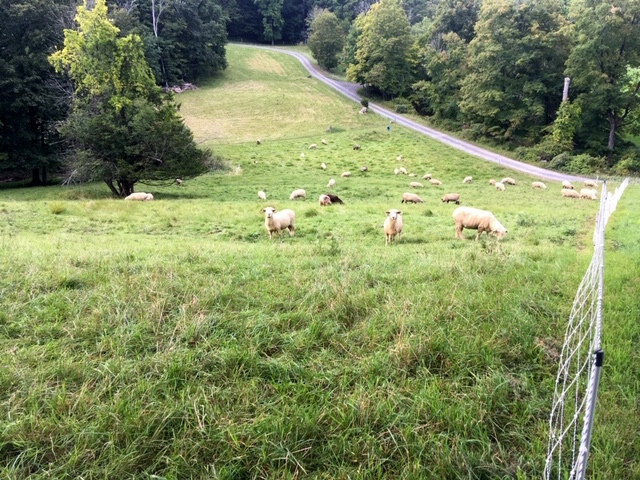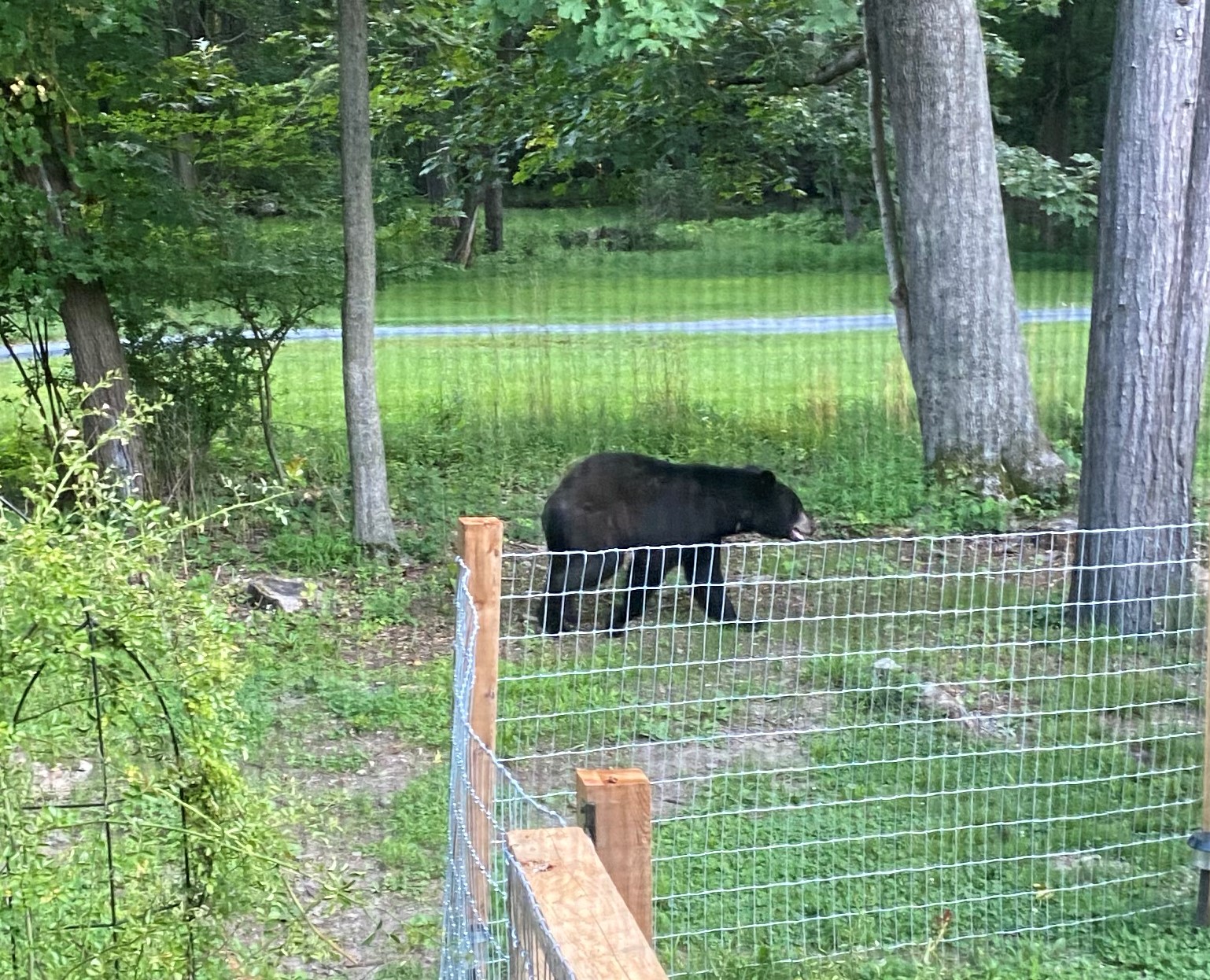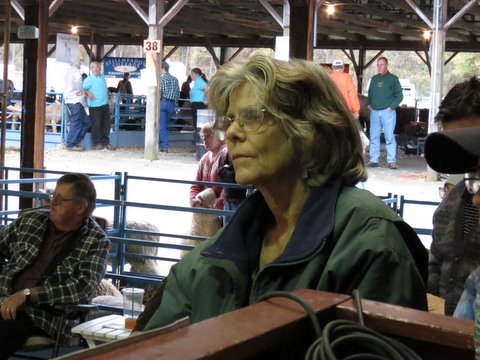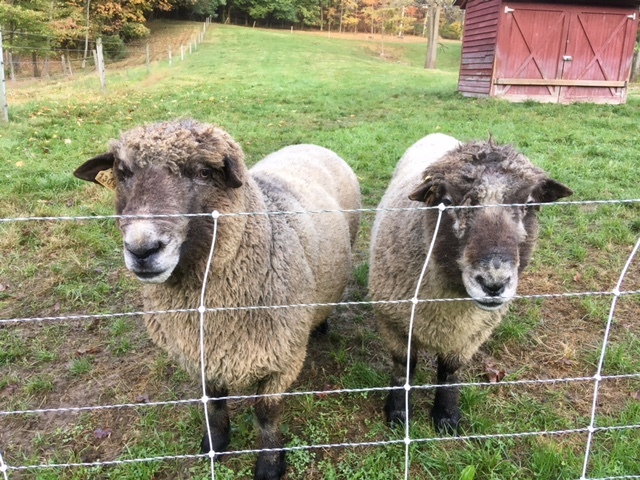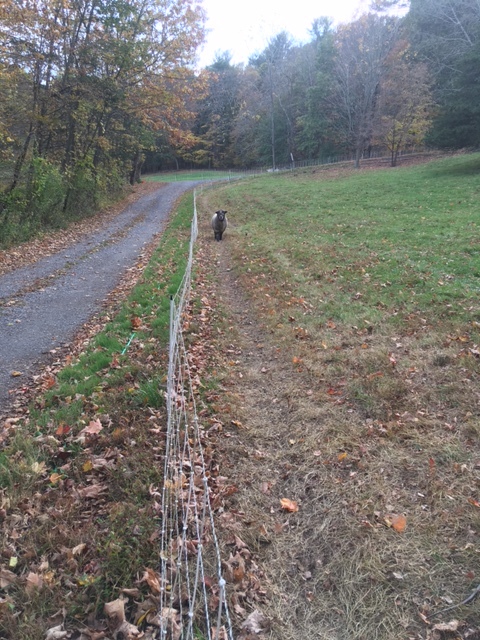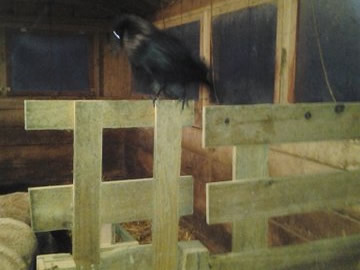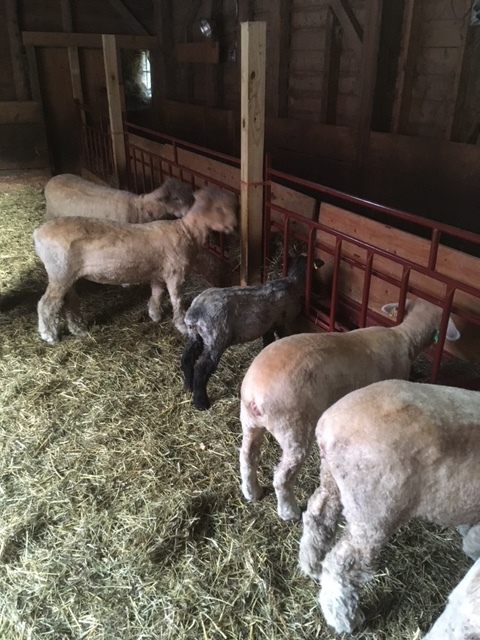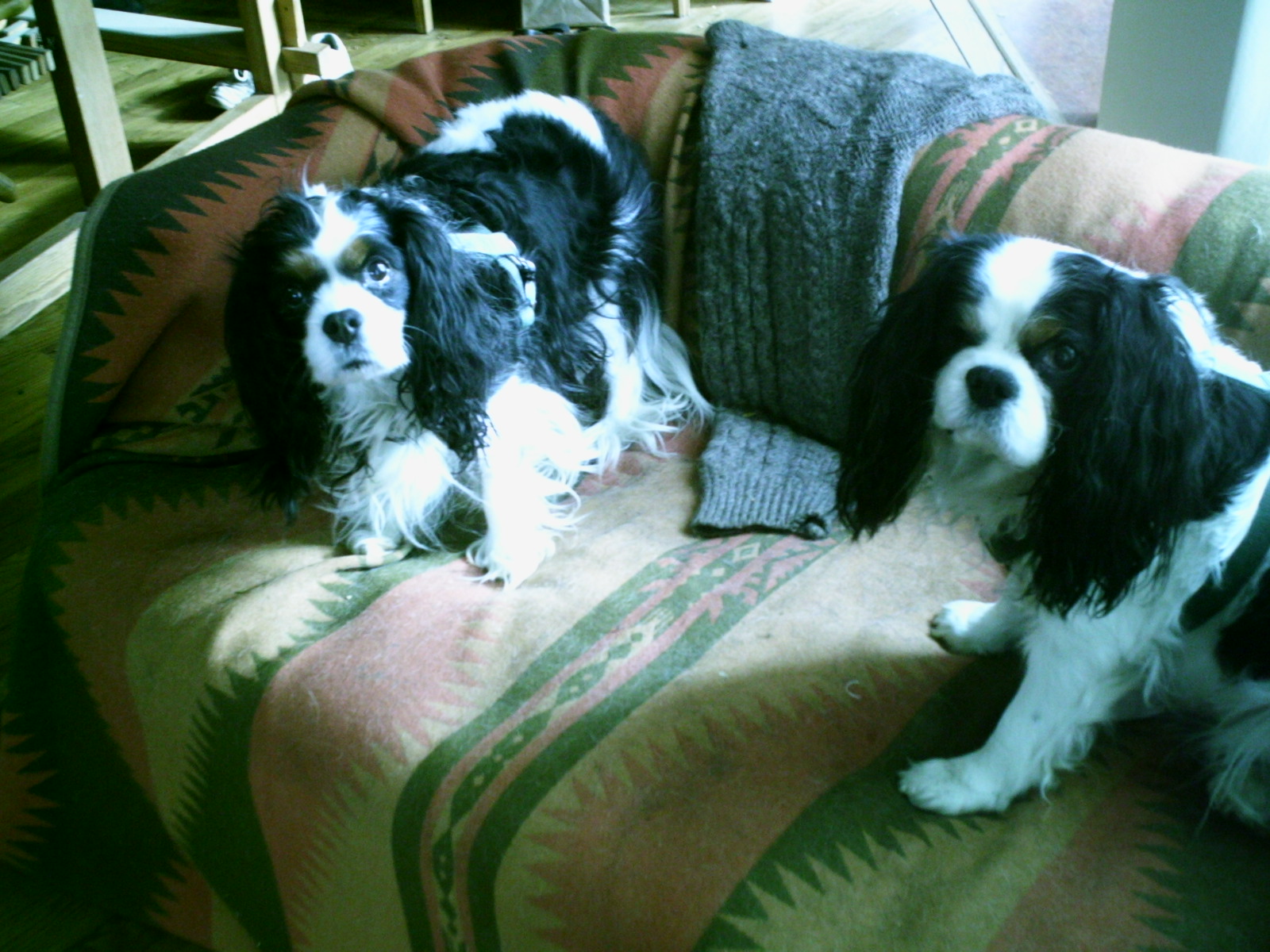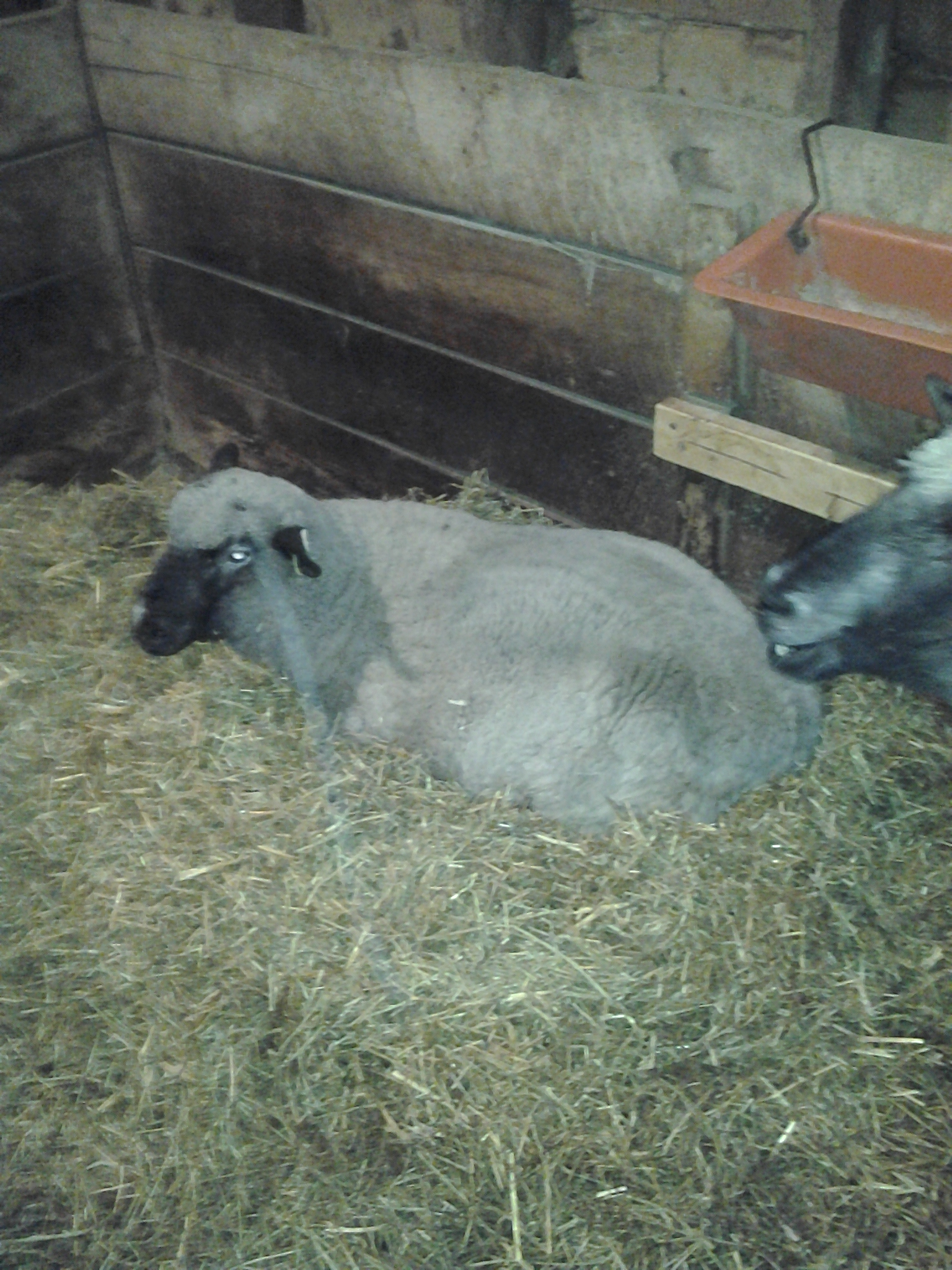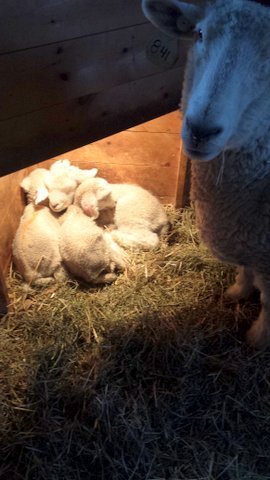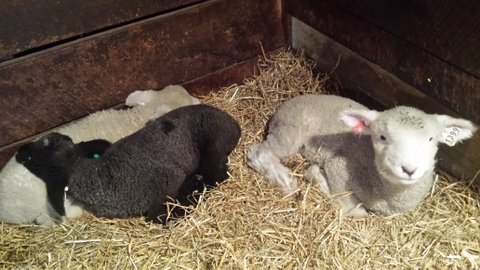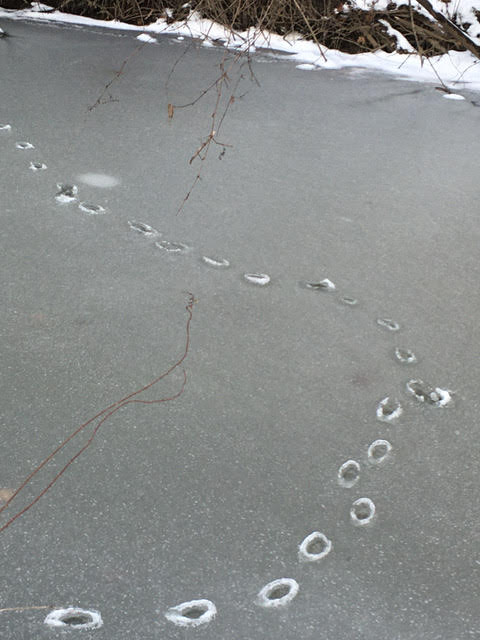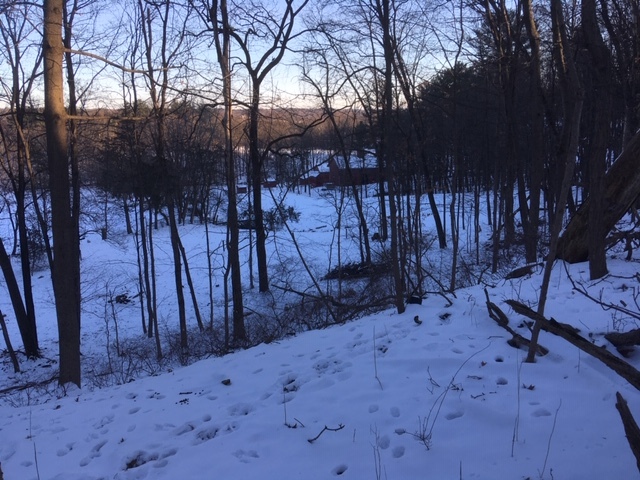Recessive Color
Introduction written several years ago, with subsequent edits and updates below:
We have, and are glad to have, Romneys who get their pigment pattern from the dominant allele at the extension locus. Nevertheless, we set out in 2010 on the road to to breeding some “recessively” natural-colored Romneys, learning from the experience of breeders like Maggie Howard, Dee Heinrich and Del Pike. Like many breeders described in Maggie’s book, we realized circa 2008 that we used to have recessively-colored Romneys in the 1980s and early 1990s but could no longer see any here. To remedy that, the first step was to use natural-colored x white crosses to “shake out” the color allele dominant at extension; second step was to uncover color alleles at the agouti locus, known in shorthand as “recessive color.” Our ram X001 from Tawanda Farms, Montague CA, was the keystone in this starting this multi-year sequence. We thank Maggie and Carol for making him available to us, and for sending us in summer 2015 two more recessive rams that we very much wanted. Read about them on the recessive color page. X001 went in 2014 to a farm in Pennsylvania that was looking for an Aa Aa ram. In late 2017, “Cary” and “Sangria” traveled home to Montague after leaving us three years of great lambs.
Early on in the quest to breed recessively-colored Romneys we lost a year in the “shake out” process through using a good natural-colored ram who. we now realize, must have been “double dominant.” Thirty-five of 36 lambs by him out of white ewes over two seasons were natural-colored, instead of the expected half. Thirty-five of 35 lambs by him out of extension-dominant ewes over those two years were natural-colored, where if he were E+ Ed we would have expected about a quarter of them to be white. [The one white lamb will forever be a puzzle to us.] Our first home-born recessive n/c ewe was born in 2012, by X001 out of a white ewe that went back to Bellairs. She was with us until 2018. Below is a year-to-year review of our agouti-recessive program, mentored by Maggie Howard and Dee Heinrich.
recessive color in 2025 Only one such lamb in 2025. All our homozygously recessive ewes had undergone AI in October 2024 with semen from KKS 7084-22, a white ram we own in NZ who has exceptional resistance to gastrointestinal nematodes like the barberpole worm. The AI took for all but two, both aged, ewes who were live-covered here by O’Hara, Tawanda F007 (see paragraph below). One of the two had (we assume) a late abortion. The elder one gave us a single ewe lamb, pictured at three weeks after birth.
Anchorage 2011-25BBR
The year-2025 lambs born here are almost all (46/52) phenotypically white. Close to 60% of those (27/46), however, are first-generation (F1) color carriers; that is, with one recessive color allele at the agouti locus, denoted as Awt Ax E+ E+. All those registered will have a BW suffix to the ARBA number. Each lamb from a union of one of these F1 color carriers and a homozygously recessive Romney has a 50% chance of being homozygously recessive and 50% of being a white F1 color carrier. Lambs by KKS 7084-22 are expected to be on average more resistant to worms and to foot problems than lambs not sired by a ram with those attributes. Just how much more resistant an individual will be cannot be predicted in in April. This must be reckoned by following fecal egg counts, FAMACHA scores and body condition into September.
recessive color in 2024, now twelve years past our first home-bred recessive, we bounced back from two lean years. Twelve recessive ewes gave birth to twenty-three term living lambs, all by O’Hara, the senior ram we got from Tawanda Farms in April. An older ewe produced a single white F1 color carrier ewe having been bred by the white BW cleanup ram. Two triplets from a ketotic mom went to Dutchess County as bottle babies and did their loving owners proud at the County Fair in August. Four ewe lambs went to a college farm flock; two ram lambs and a ewe lamb to a breeder in CT.
Based on my proposals for color alleles, five of the ten males were Albl (light blue) with the second allele being darker, i.e. dark blue (Adbl) or midnight blue (Ambl) or self (Aa). Distinguishing which of those three darker alleles is the secondary is hard. I get a lot of help from Maggie Howard, but she often advises pencil, not ink, calling for wait and see. Five of the males IMO have no allele higher (you might say lighter) than dark blue. Among the nine females, six show no display suggesting light blue, while three look like Albl with a darker allele secondary. Midnight blue is well-represented in both sexes.
1922/24 Tw with her dam, 1789. Maggie Howard proposed that this lamb is Ambl Aa
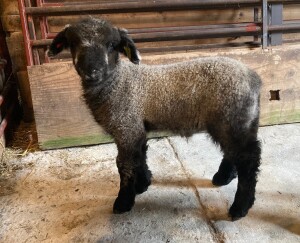 This single recessive ram lamb, 1957/24, weighed 29 pounds at age two weeks
This single recessive ram lamb, 1957/24, weighed 29 pounds at age two weeks
We plan to change this year to weaning on pasture circa mid-June rather than (as in the past) in the barn circa late April; therefore, we advise anyone interested in these lambs to visit here in April to be able to see and handle lambs before they are on pasture round the clock.
2023 events In a deliberately curtailed breeding season fall 2022, no recessive ewes became pregnant.
2022 news Ten years into our agouti recessive program came a setback: a handsome recessive ram with whom we’d put thirteen recessively-colored ewes bred only one of them. Luckily that striking ewe lamb (1867/22) is still with us. She had beautiful twins this year, both with a strong light blue display like their maternal grandsire and their sire.
2021 news on recessive color It’s now nine years since our first home-bred recessively-colored lamb in 2012 and five years after we began, in 2016, to have a consistent yearly crop of recessively-colored lambs. In early 2021 we saw 15 such, all from the same sire (Anchorage 1621-19) out of eight recessively-colored ewes. Eleven of the fifteen are very dark with no teardrops, what I call VDNTD (see 2020 news). Seven of the fifteen have been presented to Maggie Howard’s sheep color genetics list serve. Not one of the fifteen has, to our eyes, a light blue allele. We love the very dark alleles but don’t want to turn our recessive program into the New Zealand rugby team. In early summer we acquired a recessive ram with a light blue allele to use in fall 2021.
2020 news on recessive color 19 recessively-colored lambs about half of which had no teardrops. I take that lack to indicate that neither agouti allele is dark blue or higher. We’re left with midnight blue (Ambl) or possibly paddington blue (Apbl) or yet another unidentified very dark allele above self (Aa) or else self. For my own convenience though not illumination I’ve taken to referring to such sheep as VDNTD “very dark no teardrops.”
2019 news on recessive color We had a lot, with a number of lambs that appear to us to have no allele higher than dark blue and whose second allele must be dark blue, midnight blue or self.
2018 news on recessive color Review of previous three years’ experience below.
We put fourteen ewes August 2017 to one or the other of our two recessively-colored rams from Tawanda Farms. Two ewes are we think “pure white” Awt A_; seven are “white color-carriers” Awt Ax; and five are recessively colored (shorthand Ax Ay). Twenty-six lambs were born late Jan to early Feb: ten pairs of twins, one set of triplets and three singletons. Twenty-five are doing well as of April 8l one (1560) was found dead early April having shown no symptoms of illness. This leaves twelve recessively-colored lambs out of the 13 born. The two Awt A_ ewes produced as expected four white lambs that have to be Awt Ax. The five Ax Ay ewes had eight Ax Ay lambs The seven Awt Ax ewes bred by an Ax Ay ram had among them five “recessively-colored” AxAy lambs and nine “white color carrier” Awt Ax ones.
“Proposals” for the agouti alleles in the recessively-colored lambs are in the works, helped by several viewers on Maggie Howard’s list. We’re seeing a preponderance of the darker alleles. The recognition last year by Maggie and Dee of the midnight blue allele in Romneys calls for careful watching by us, more so as Maggie has with reasonable certainty revised the putative agouti alleles on her X001 ram who is grandsire to most of our recessives. In 2010 she had thought him Aa Aa, but a second, careful look at old photos this year made that Ambl Aa. We are sure there’s some midnight blue here, but can’t put a confident finger on it.
The Romney Recessive web site was balky for some time about accepting new photos; so I switched, like several others on the list, to attaching photos to an email. This made it harder for observers to give their opinions on agouti alleles, putting me more on my own. All thirteen of our recessively-colored lambs had very distinct teardrops. That rules out Aa Aa and Ambl Ambl. In only one of the lambs, 1560, who died just before weaning, did I definitely see light blue (Albl). I thought he might be homozygous, but others were not sure of that. By process of elimination, then, all our surviving lambs have at least one agouti allele at the dark end of the spectrum, with dark blue (Adbl) the allele that I can light upon most comfortably. Distinguishing the newly-described midnight blue (Ambl) from Adbl in combination with anything is beyond me; I have to rely on others. If you want the dark end of the Romney agouti spectrum, ours is a good place.
Having on April 4 weaned all but one of our recessively-colored lambs, we are offering ram and ewe lambs for sale at the farm. Ram 1559-18BB, our biggest recessive fella, will probably be consigned to the sale at Maryland Sheep and Wool in early May He is a singleton, born Jan 31 b.w. 14 lbs. weaning weight at 64 days 70 lbs. His dam (1126) is out of Tawanda X001 (Ambl Aa). Her dam was Awt Ax from Applewood Acres. The lamb’s sire is Tawanda Cary (Albl Adbl pretty certain). I have penciled 1559 in as Adbl A_ . He has too much white on face, neck and ears to make Adbl a ready fit for the second allele, but not enough white overall to make me at ease with Albl suppressed by a very dark second allele. His tail tip was all dark; we don’t think he has spotting. After consulting with three knowledgeable friends who reviewed the pictures, I am conservatively standing on Adbl A_ . If you would like to see pictures, email me, Stephen, using corrected version of address shpcount[at]earthlink.net.
We have seven other recessively-colored rams that don’t display spotting (and two that do, whom we won’t offer for sale). 1570 and 1571 are twins on both of whom Maggie and I pencil in Adbl Ambl. 1578 is a singleton with the same pair posited by another observer and me. Ram 1594 is a twin where I call without corroboration Adbl Ambl or Adbl Adbl.
We only have three recessively-colored ewe lambs but need not cling to them 1556 Tr, 1558 Tw, and 1577 Tw. All are quite dark.
Speaking of the rams from Tawanda Farms (Cary and Sangria), they are being repatriated to Montague CA after three years here. They are related to all our recessives. It was a privilege to host these good ol’ boys. Thank you, Maggie and Carol, we will miss them but have their sons. We were hoping in 2018 to have to decoded Sangria’s agouti alleles, but of his nine lambs out of Awt Ax ewes , six were white and gave no clues.
2017 News Proposed Agouti Allelotypes 2017 Recessive Lambs
Agouti alleles of the lambs were “proposed” using a composite of my proposals based on lamb photos integrated with proposals from Maggie, Dee, Melissa W, Michaela and Kelly, who all generously weighed in on most or all of the lambs. This could grandiosely be called a very unsystematic version of the Delphi method for decision-making. The “final” proposal, shown below, had to be compatible with information I have about parental and grandparental agouti allelotypes.
Four recessively-colored lambs (1472, 1480 1481 1482) were born to white color carriers known to be Awt Aa. This allowed us to be certain that in each the agouti allele “higher” than Aa came from the sire, narrowing the choices in these two sires to a relatively easy call between Albl and Adbl. One of the sires (Tawanda’s Cary) is proven to be Albl Adbl. The other, Tawanda’s Sangria) is Albl Adbl or Aa
The proposals for these four lambs are in bold below as more solid than those for the other five recessive lambs. All of these nine, even the ones in bold, must be validated down the line. The bold ones we have more confidence in; the others are so to speak in lighter pencil.
Comment: We seem at Anchorage to have a limited palette of single color alleles: Albl, Adbl and Aa. This is no surprise in that since we got into a recessive program a few years ago the rams we were privileged to use seemed to carry only those three. I have asked others why so few houses are calling English Blue or Blue in Romneys these days. They wonder if these alleles are around but masked by those we are calling dark blue and self. We all need to keep our eyes out.
All nine lambs are in the Anchorage 2017 album. The “final” proposals, none progeny- proven, are as follows, grouped by type of dam:
Four white color carrier ewes put to a recessive ram bore 9 lambs in total
Five lambs were colored (1472, 1480, 1481, 1482, 1502) AxAy. More specifically,
1472 Adbl Aa
1480, 1481, 1482 all Albl Aa
1502 Adbl Aa
Four lambs (1473, 1484, 1503, 1504) were “white color-carriers,” all considered Awt Ax
Two “pure white “ ewes (Awt A_) had 3 lambs (1476, 1477, 1491) all noted as Awt Ax
Two “recessive” ewes (Ax Ay)had four lambs ( 1474, 1475, 1478, 1479) all noted AxAy, specifically
1474 Albl Adbl
1475 Adbl Aa
1478, 1479 Adbl Aa
Recessively-colored lambs from 2017, by sex and proposed agouti allele pair
Rams Ewes
1472 Adbl Aa (not for sale)
1480 Albl Aa
1474 Albl Adbl 1481 Albl Aa
1475 Adbl Aa 1482 Albl Aa (not for sale)
1479 Adbl Aa 1478 Adbl Aa (not for sale)
1502 Adbl Aa
2016 NEWS
In 2016 our effort to breed recessively-colored Romneys finally bore fruit after five years of halting progress. Many thanks to Tawanda Farms for letting us harbor three wonderful rams of theirs. Thanks also to Regina Embler for sending us a lovely white color-carrier and to Dee Heinrich for teaching, advice and encouragement over the last ten years.
On the ground now (March 3) we have eleven lambs (3 ewes and 8 rams) that are recessive beyond question and five female white color-carriers (Awt Ax E+ E+). All are sired by “Cary” or “Sangria.” Both rams came from Tawanda Farms last summer. The grandsire of most of the eleven lambs is Tawanda X001 (Aa Aa). SORB 127, definitely recessive (Ax Ay no lamb photos) is grandsire of a set of triplets (two n/c one white). “Cary” we are now quite sure is Albl Adbl. “Sangria” was called by Maggie Albl Adbl or Albl Aa. His lambs here suggest that his second allele at agouti besides Albl is Aa. This is a good place to thank Maggie and Dee and Melissa for their patient scrutiny of lamb photos on which the rest of us depend for guidance.
Pictures of the lambs can be seen on the Romney Recessive yahoo group in the Anchorage 2016 album, with discussion of proposed agouti allele pairs (“genotype”) on the list serve. Three lambs (one ewe and two rams) are agreed-upon by all those who commented to express a light blue allele over a darker one that could be either self or dark blue. All the others look like dark blue paired with dark blue or self. All eleven have symmetric “teardrops.”
We are extremely interested in having some of these rams and at least one of the three ewe lambs go into other programs that make a point of recessively-colored Romneys. The color-carrying white ewe lambs could also come in handy for someone who has a recessively-colored ram they like and wants to play the 50-50 odds of getting recessively patterned lambs from that union.
There are too many pictures (over fifty) to post here. We have a table that shows all the recessive lambs and white color-carriers by sex and parentage and proposed agouti allelotype with comments on “spotting.” We’re happy to send this to anyone by e-mail, as it does not fit into this space. Glad also to provide pictures of individuals if you are not on “Maggie’s List,” which we strongly recommend you join. Give a call to Graeme 845 399 2379 to get more information and arrange a time to come to the farm if you are close enough. If you are far away, call anyway.
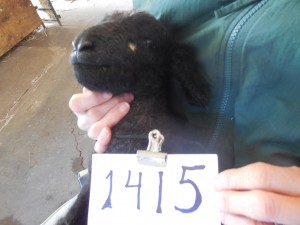 To the left is a photo of 1415 showing his left-sided teardrop. Symmetric teardrops like this one are all he sports of white except a small white tuft on left side of brow that may be spotting. No white on tail tip. Dam is Awt Aa E+ E+ Sire is “Cary” Consensus of comments on Romney Recessive list re 1415: Adbl Aa E+ E+ . This lamb illustrates the value of having white color carrier ewes that are Awt Aa E+E+. His sire was called by Maggie either Albl Aa or Albl Adbl. This lamb, though you can’t see it from this picture alone, is definitely Ax Aa but has too little white display to be Albl Aa; ergo, his Aa came from his dam and his other agouti allele has to be his sire’s darker agouti allele, adbl; ergo, his sire is Albl Adbl.
To the left is a photo of 1415 showing his left-sided teardrop. Symmetric teardrops like this one are all he sports of white except a small white tuft on left side of brow that may be spotting. No white on tail tip. Dam is Awt Aa E+ E+ Sire is “Cary” Consensus of comments on Romney Recessive list re 1415: Adbl Aa E+ E+ . This lamb illustrates the value of having white color carrier ewes that are Awt Aa E+E+. His sire was called by Maggie either Albl Aa or Albl Adbl. This lamb, though you can’t see it from this picture alone, is definitely Ax Aa but has too little white display to be Albl Aa; ergo, his Aa came from his dam and his other agouti allele has to be his sire’s darker agouti allele, adbl; ergo, his sire is Albl Adbl.
In praise of Awt Aa E+E+ ewes: such don’t grow on trees, but they can be bred for if you are working with a ram you are sure is Aa Aa E+ E+. I am so glad that Maggie Howard advised us to start our recessive program a few years ago with an Aa Aa ram and sent us a really good one.
Pleasant surprise recessive ? lamb posted 2014 but later retracted
“On March 9 [2014] was born the natural-colored lamb with the most prominent symmetric and all-over display of white that we’ve ever had. Lamb tag PT419 Neither parent was known to carry a color allele at agouti, but I queried the Romney recessive list, took their suggestions to shoot more photos and describe details hard to see in photos. Conclusion is that she probably is “recessive.” Genotype proposed by one very knowledgeable viewer is Albl A_ E+ E+. Not easy to see in photos but relevant is that the bottom rims of both ears to about halfway from skull to eartip have white fiber. There is a half-cm patch of white fiber in the center of both ears on the anterior aspect (“inside”). No white under the tail base and no white on the tail tip [emphasis added Jan 28 2018]. The lamb’s flock ID is 1295-14 Tw. She had a white male twin that we did not keep. Her call name is ‘Bronwyn.’ Bronwyn’s dam is 1007B. She looks like an extension dominant Romney. The dam’s sire we are near-certain is Ed Ed. It is not impossible that he is Ax A_ Ed Ed . Even less likely, but not impossible, is that he is Ax Ay Ed Ed
The dam’s sire, pictured above, has a marked, very symmetric, arc of white that raises this possibility. Can color alleles “shine through” Ed?
The sire of PT419 is white with no clues in the previous several generations about the origins of the color allele at agouti we have to impute to him in believing PT419 to be recessive.
Below are pictures of PT 419 at about one week of age. (L to R) face from above; ventral aspect showing lateral stripes; left side; anterior aspect of neck showing white jabot; medial aspect rear legs; right side, showing swirls like left.
Of course we can’t be certain that she has two color alleles at agouti until we see her progeny by a ram of proven genotype. Her arrival has made clear to us the importance of early-life photos, which I had not understood at all until we came face to face with her. To many people this is old-hat, but not to us. Her unexpected arrival has given extra impetus to cultivate recessive color genes in our flock. We thank the Romney recessive listers who shared advice about her possible genotype — Christine, Dee, Del, and Maggie.” [Here ends the posting from 2014.]
Retraction!! In 2015 I wrote on this web site “One year later we are reappraising [PT419]. She is very big to be recessive, and after 2015 conversations about “spotting” with recessive color mavens I have to say her facial white is probably spotting. She did have in her lamb photos symmetric white displays that did not cross the midline and do suggest recessive patterning — in ears (not seen on these photos), ventral aspect and inside legs. I’d now say odds are that she is extension dominant with a spotting display that mimics a recessive pattern remarkably. There’s been a lot of good discussion on “Maggie’s list” about how troublesome (but how spectacular) spotting can be. Common sense says get rid of spotting, but we don’t want to altogether. We have not decided how to breed her.”
Further news posted March 2016. “Still uncertain about the color alleles in Bronwyn, we thought it best to treat her as Ed with homozygous spotting SsSs and bred her to our Extension-dominant ram. In mid-Feb she had natural-colored twins (with no white evident on them) unattended but did nothing for them. Graeme found them both dead. We decided not to forgive her this failure even though it was her first lambing and we won’t keep her. Looking at the pictures, however, I am still struck by the symmetry of the white display that does not cross the midline. There are no “teardrops” although the facial saltire (chi or St Andrew’s cross) is so big it could perhaps mask low hanging blobby ones. Circumstantial evidence has to support the call of A_ A_Ed E_ Ss Ss but she certainly is a good mimic of AxAy E+ E+ Ss Ss and we will keep her story public as instructional.”
Update (2018) to the retraction is to recall that Dee in 2014 expressed worry that the facial pattern was due to spotting, but [perhaps to avoid raining on my parade] tilted slightly to recessive. I think she was right from the start. Looking in Jan 2018 at the photos from 2014, I note (a) though I then called a “chi” blazon (or saltire or St Andrew’s cross) this was not a good example. The upper V is completely filled with white. (b) More important, though, the photo shows the contrast between the bright white that we now think was spotting and the more tan splotch of the cap posterior to the white. The tan, duller, cap may be a characteristic of extension dominant Romneys that is due neither to spotting nor to the agouti locus. Dee and I and Maggie are these days wondering about its nature. Whatever it is, it contrasts markedly in hue to the imperfect chi.
Also posted in 2015, unrelated to the lamb I wrongly thought recessive. was this note: “Our recessive program ran aground this year when we concluded from his progeny that the solid handsome colored ram we believed to be AxAyE+E+ probably has one Ed. I hasten to say that the eight ewes he was exposed to were not chosen to be the set that would give most information about whether he has an Ed allele; we simply assumed he did not, gave him only ewes we knew to have one or two color alleles at agouti (There are not many of those in our flock now) . He almost certainly has at least one color allele at agouti but the probable Ed makes that un-findable. We are taking some big steps to keep going in the right direction. Stay with us.”
